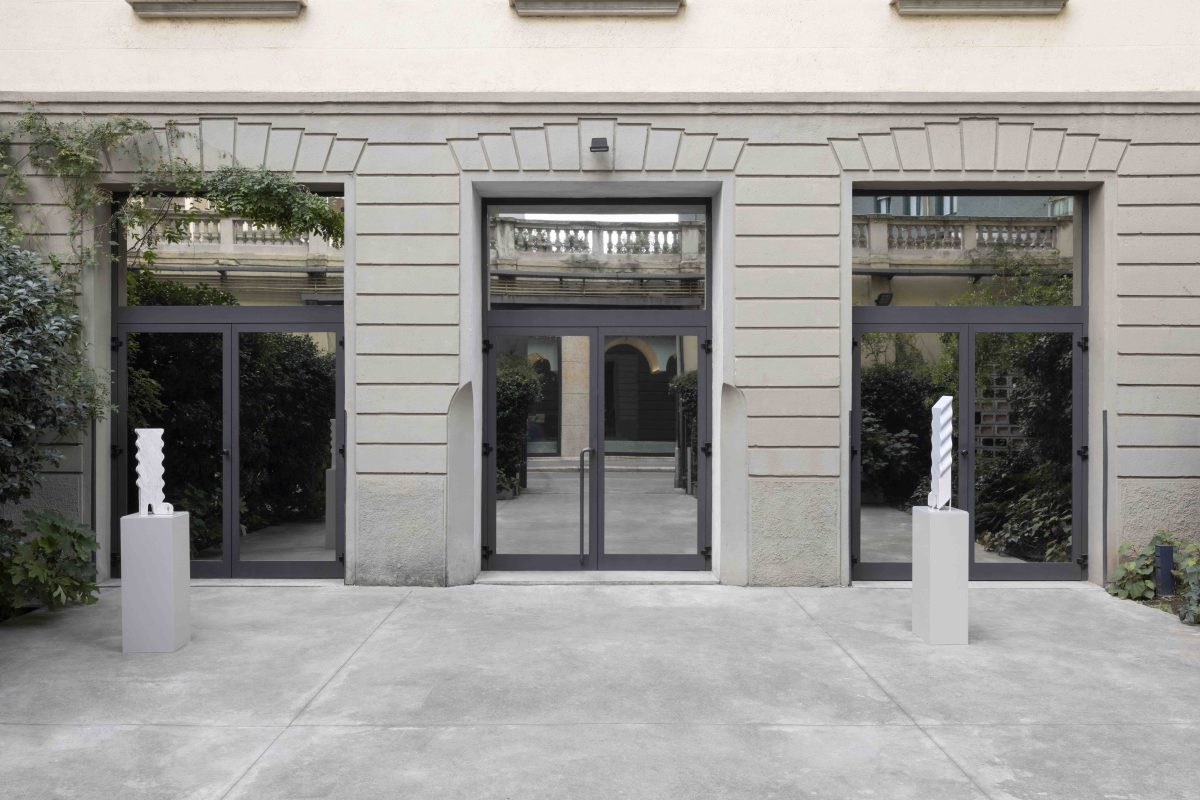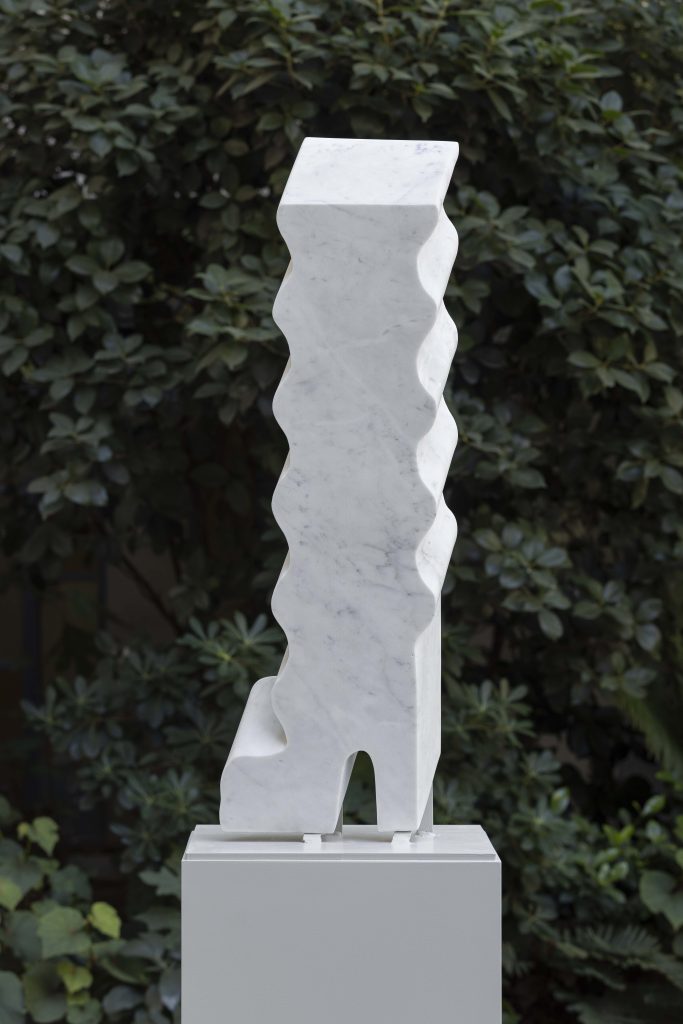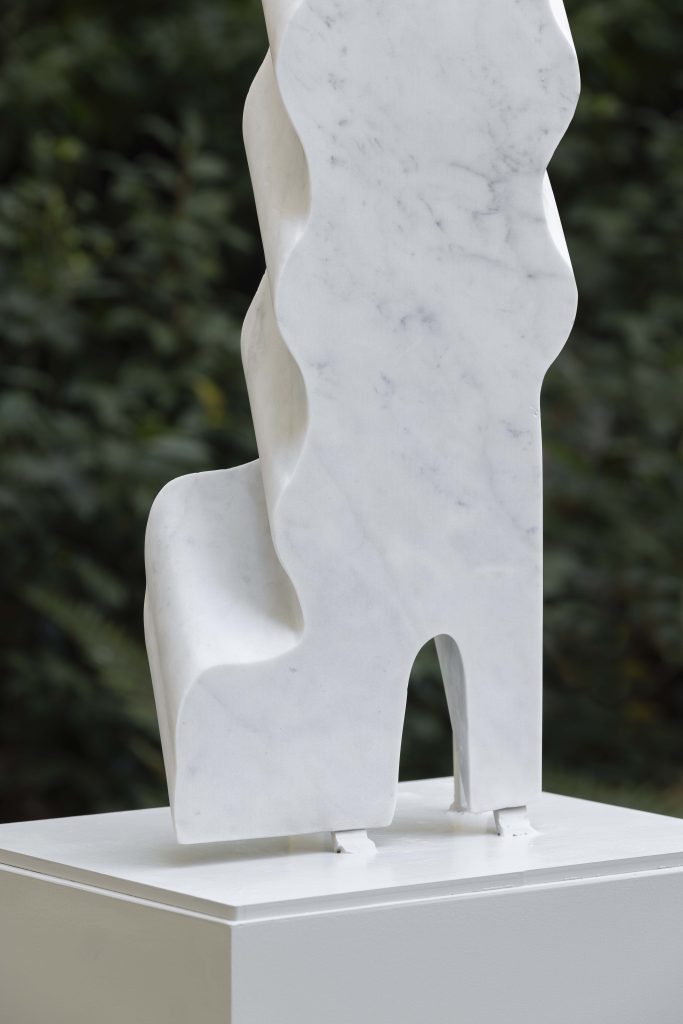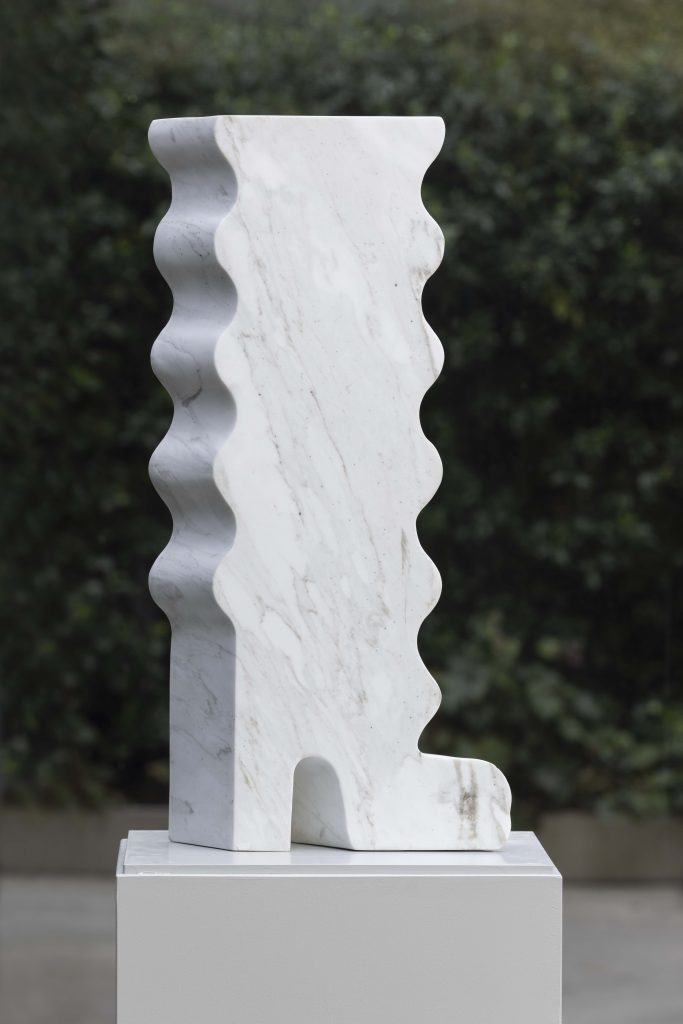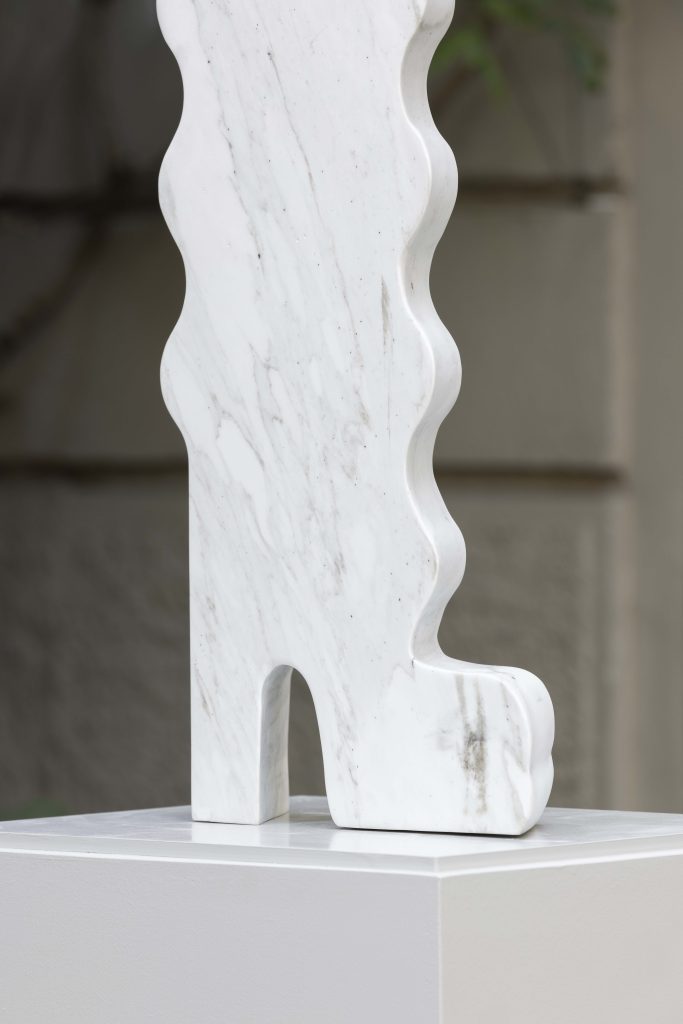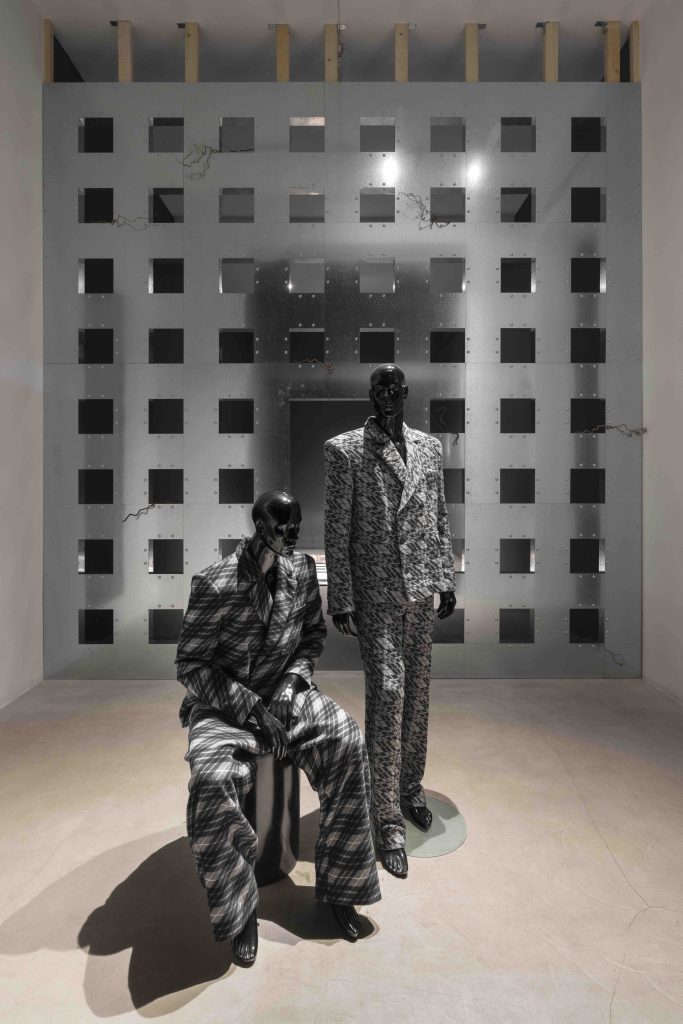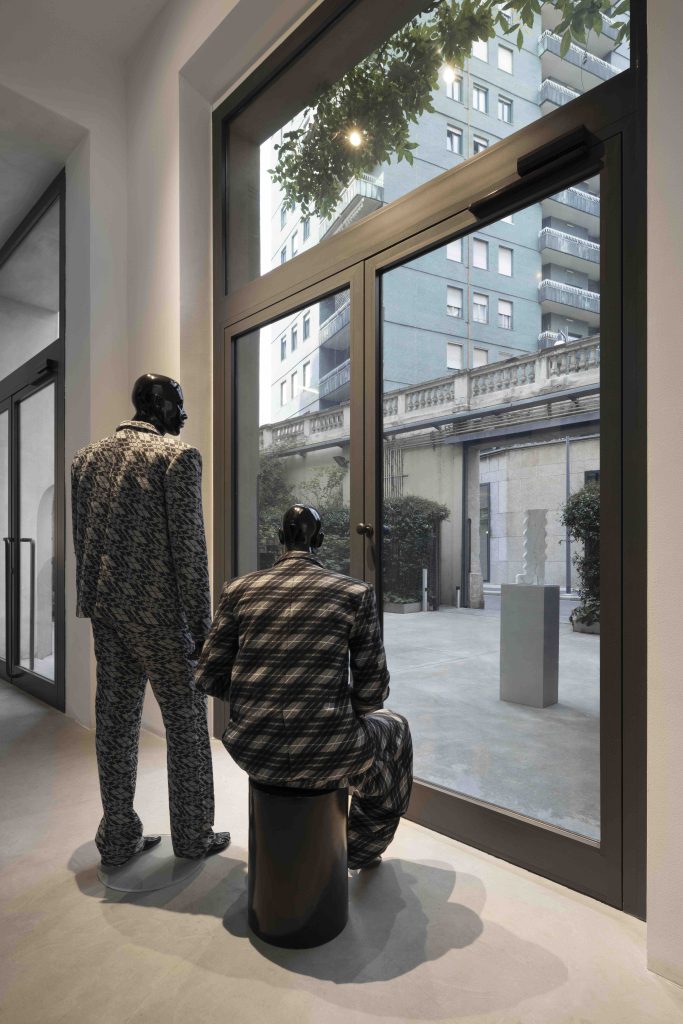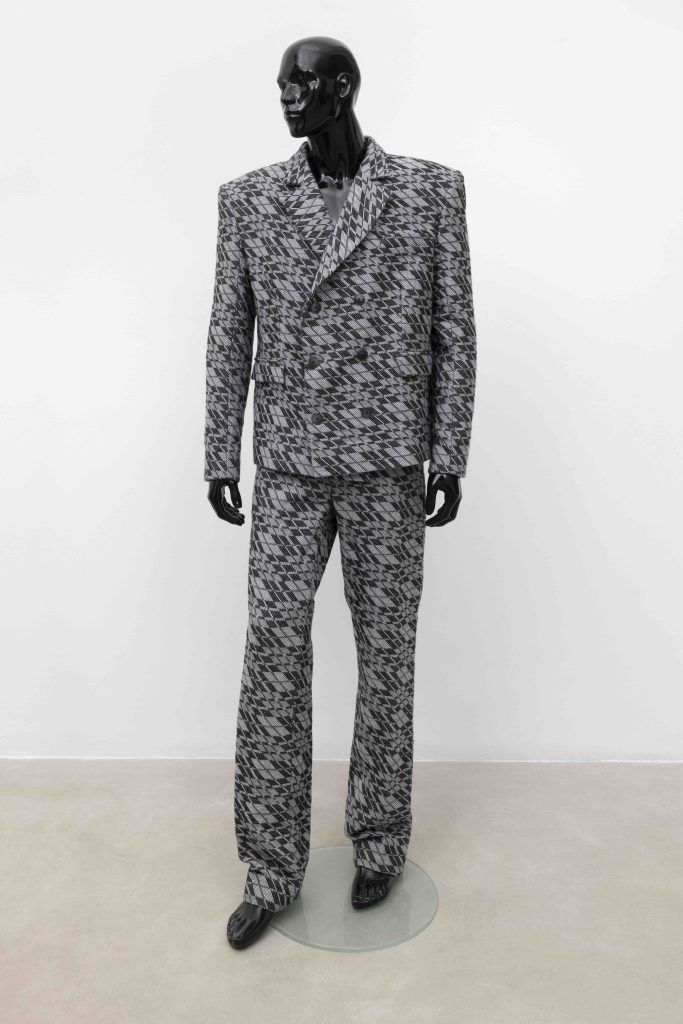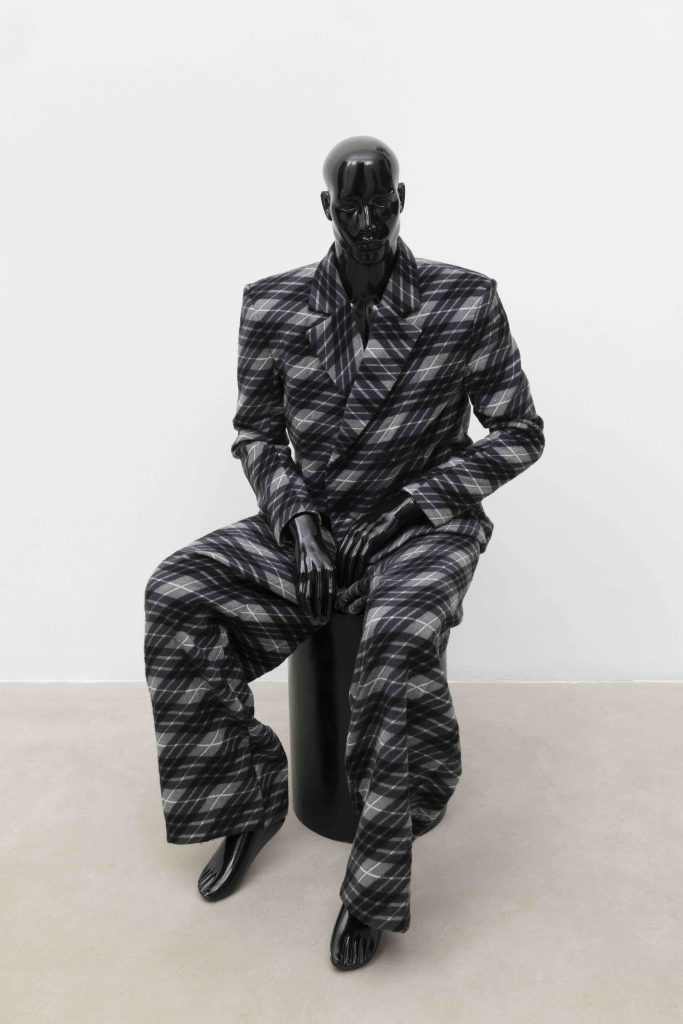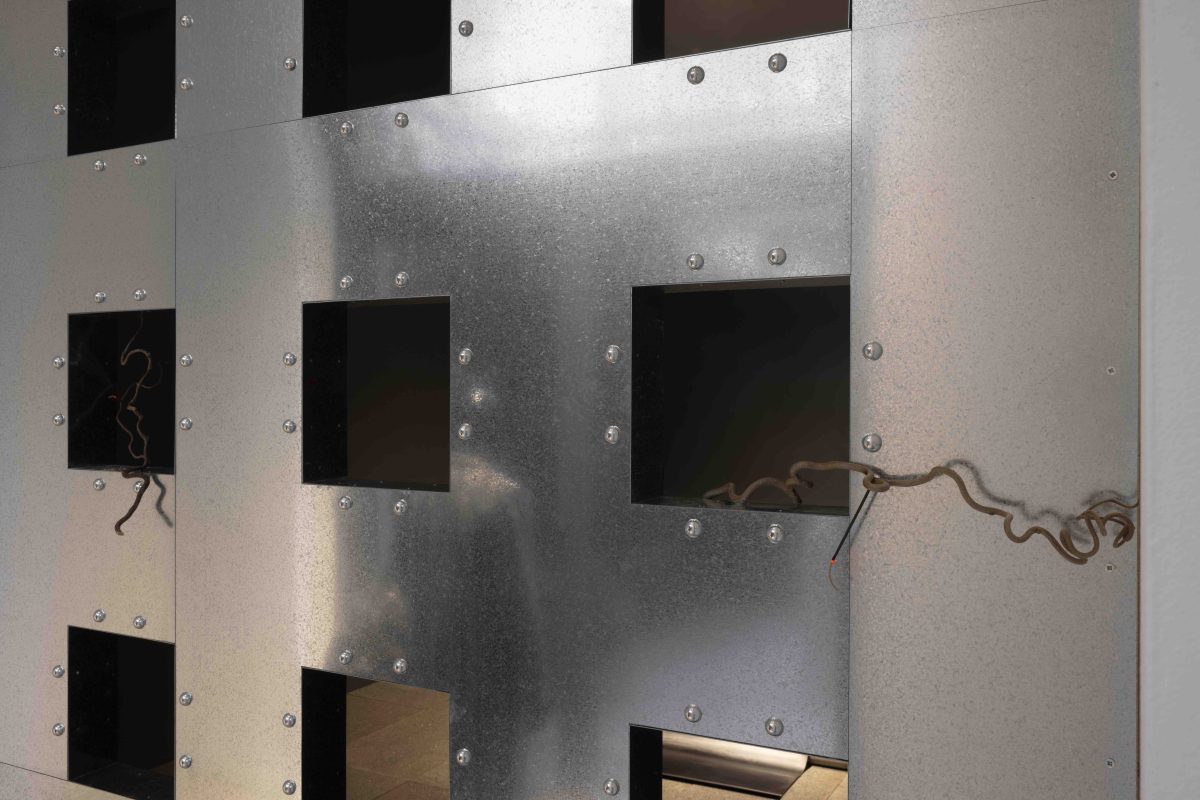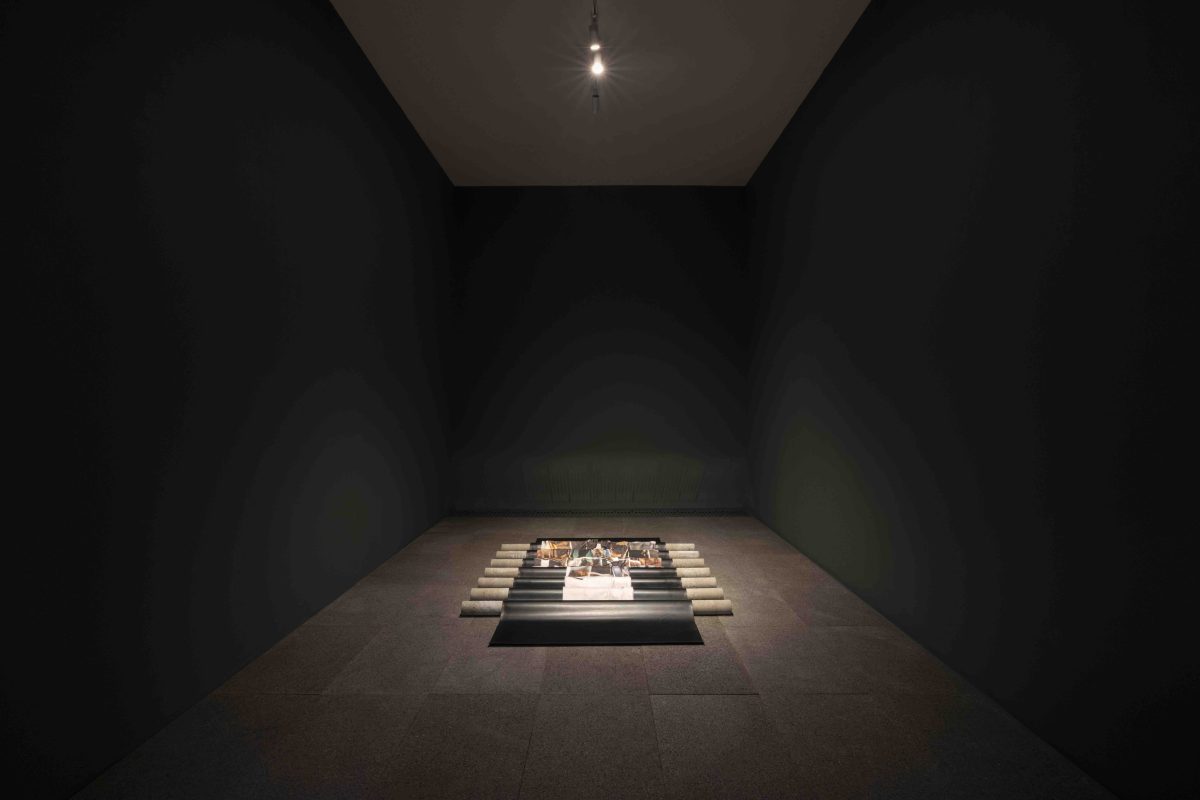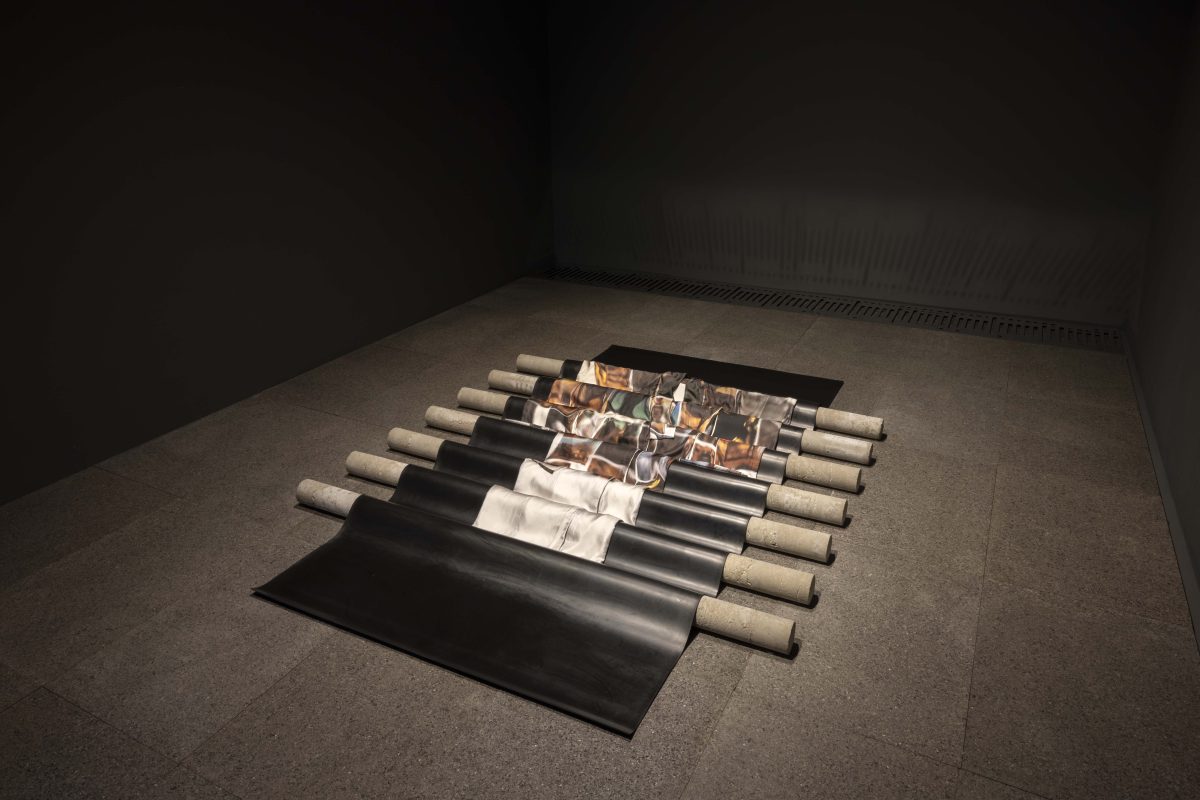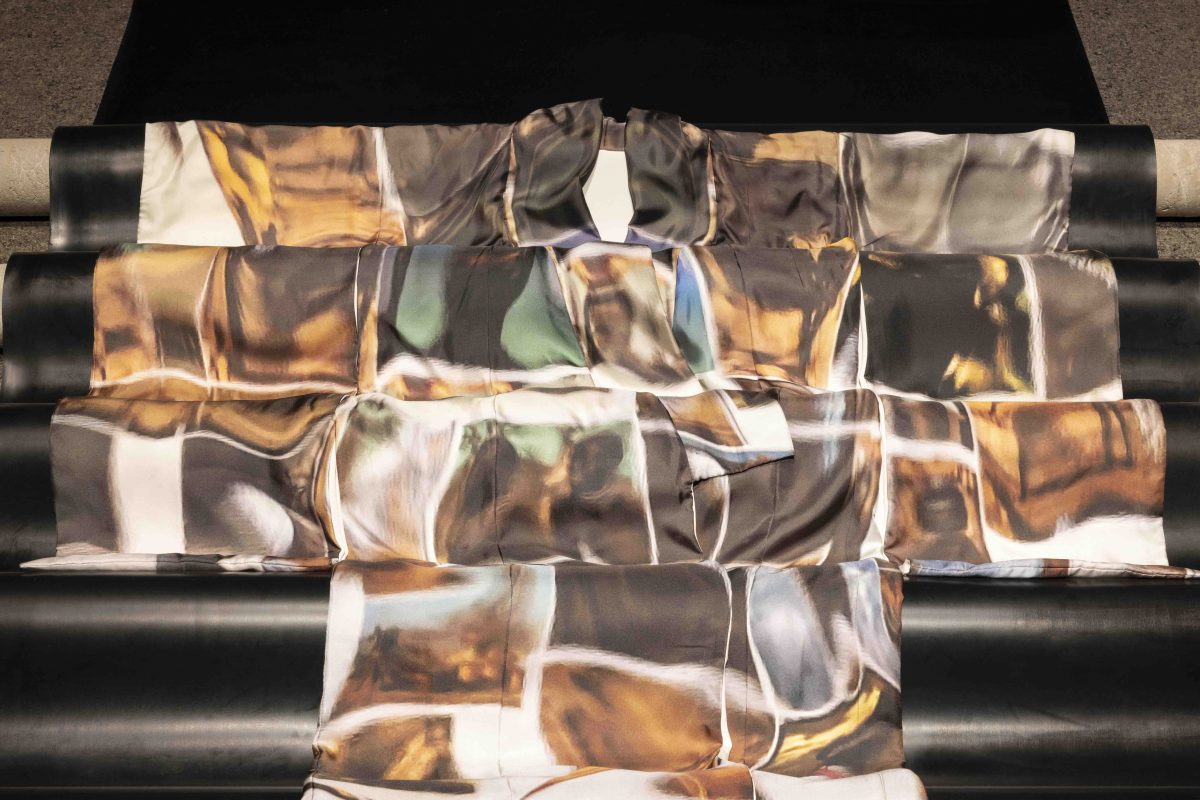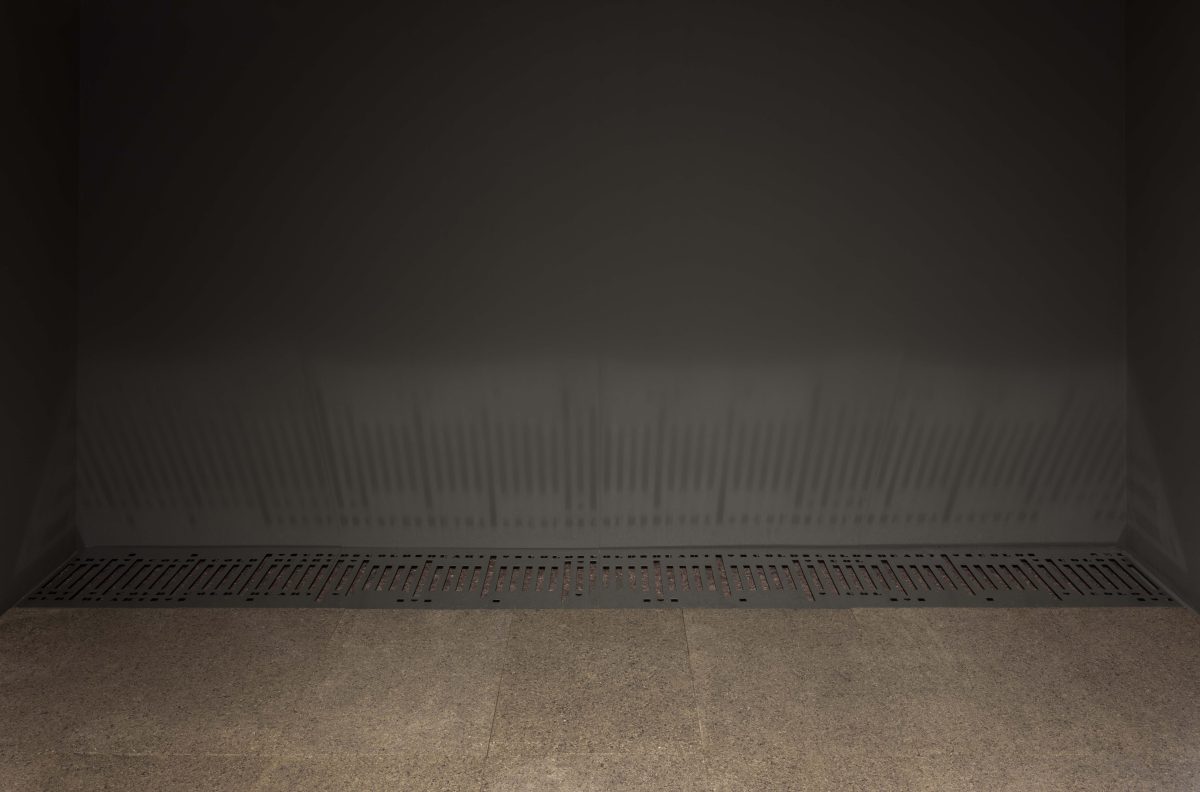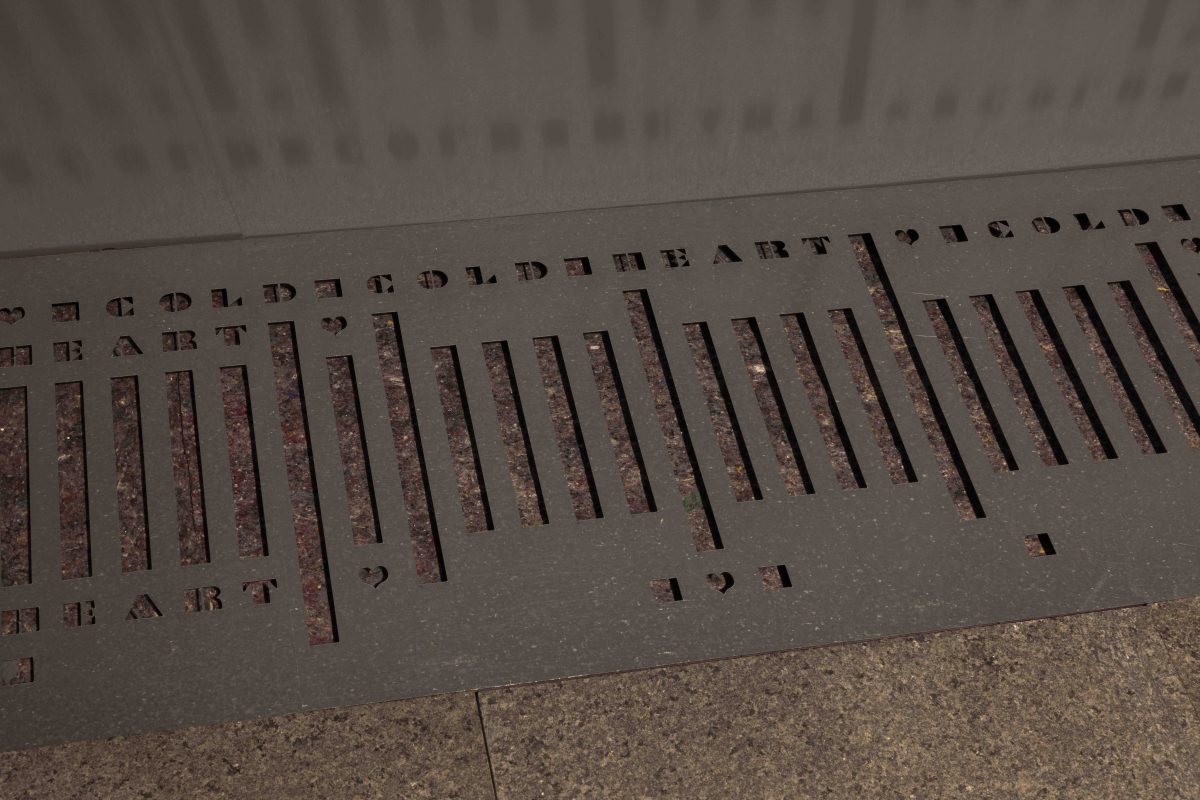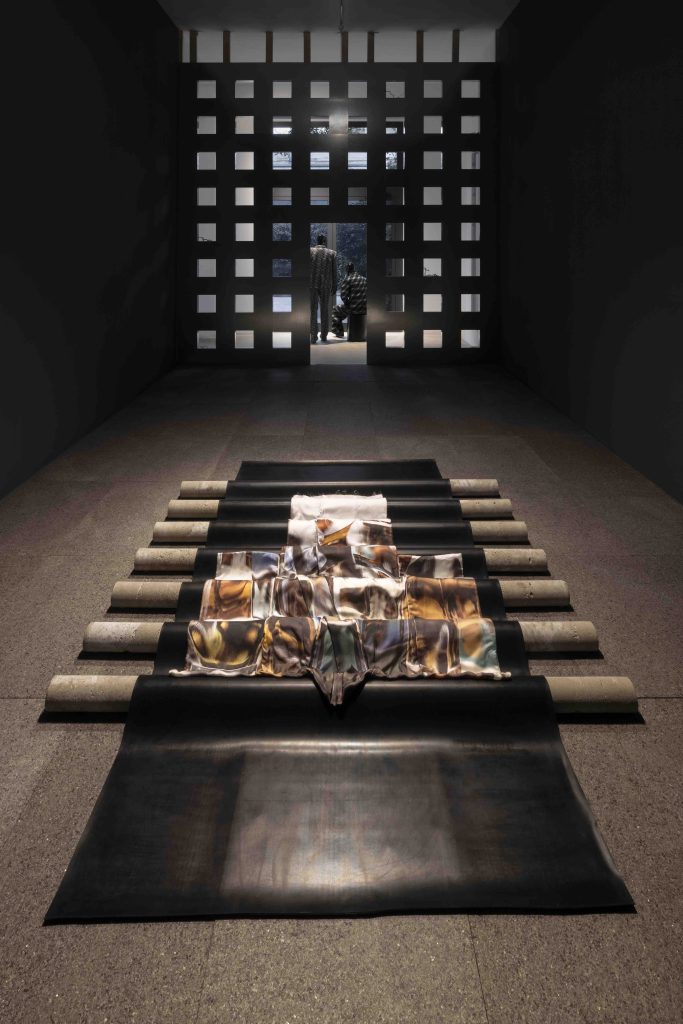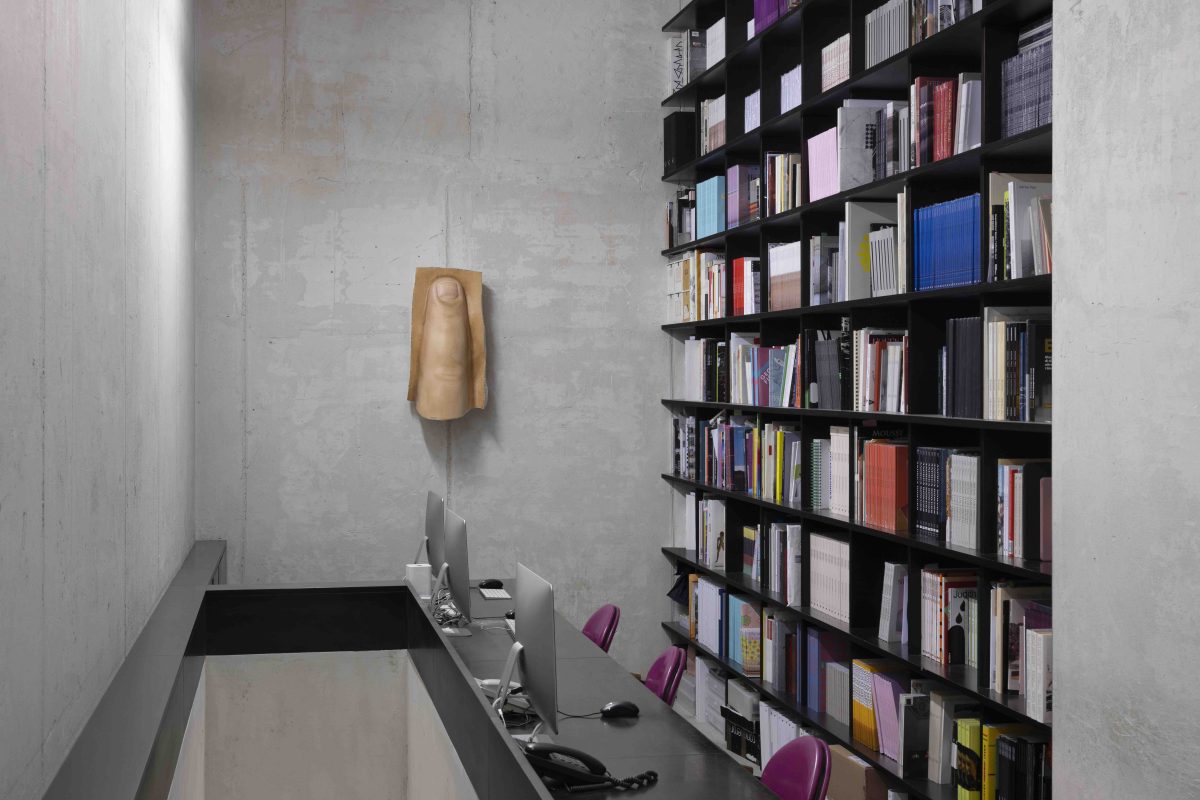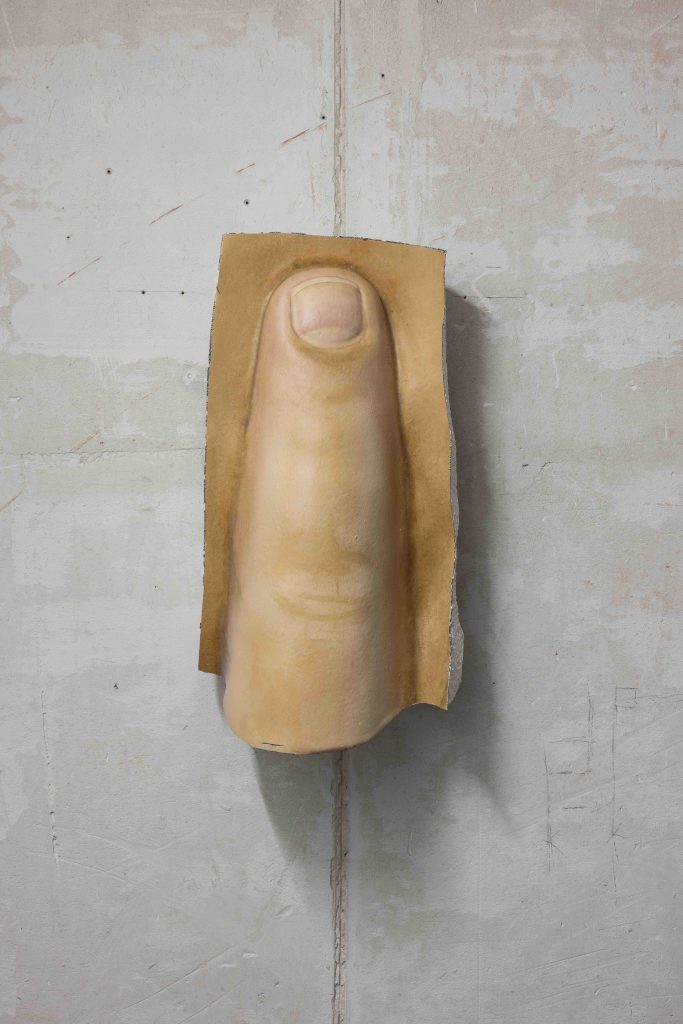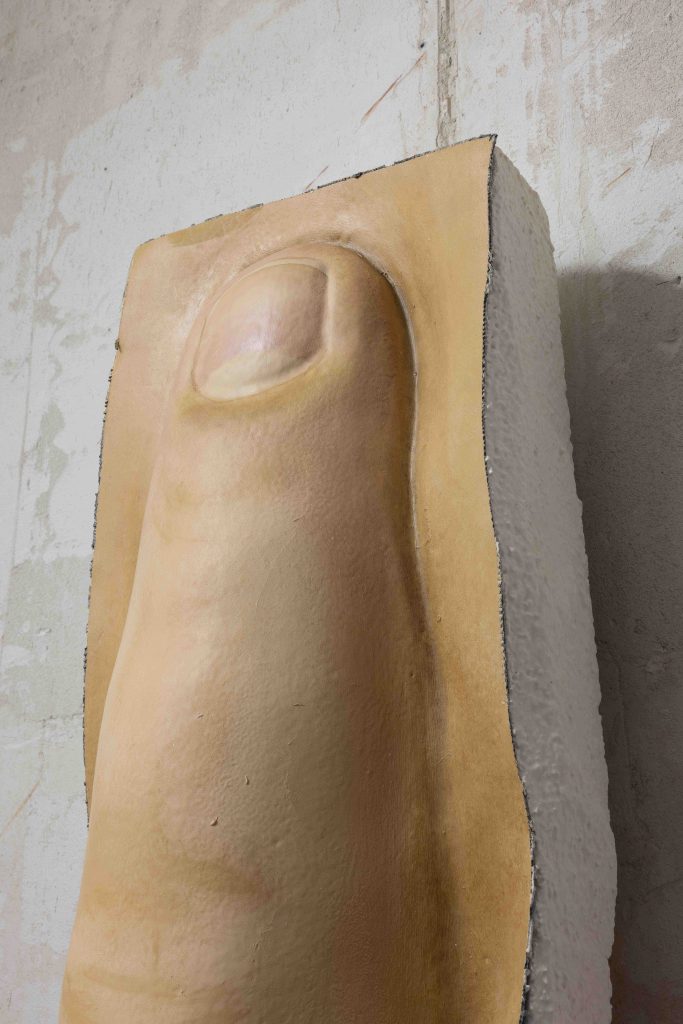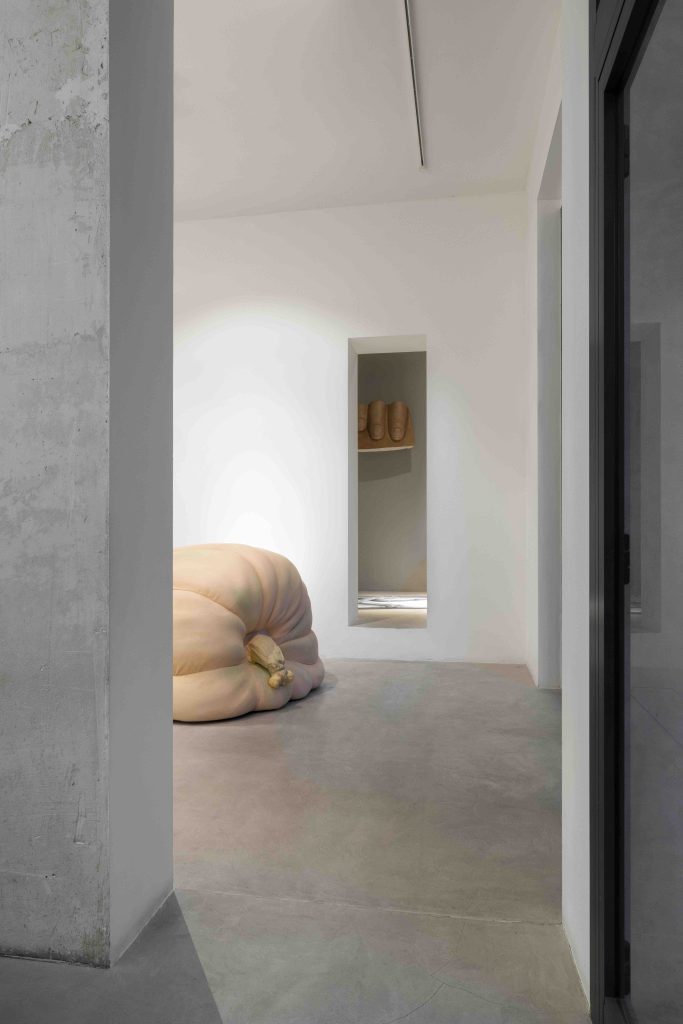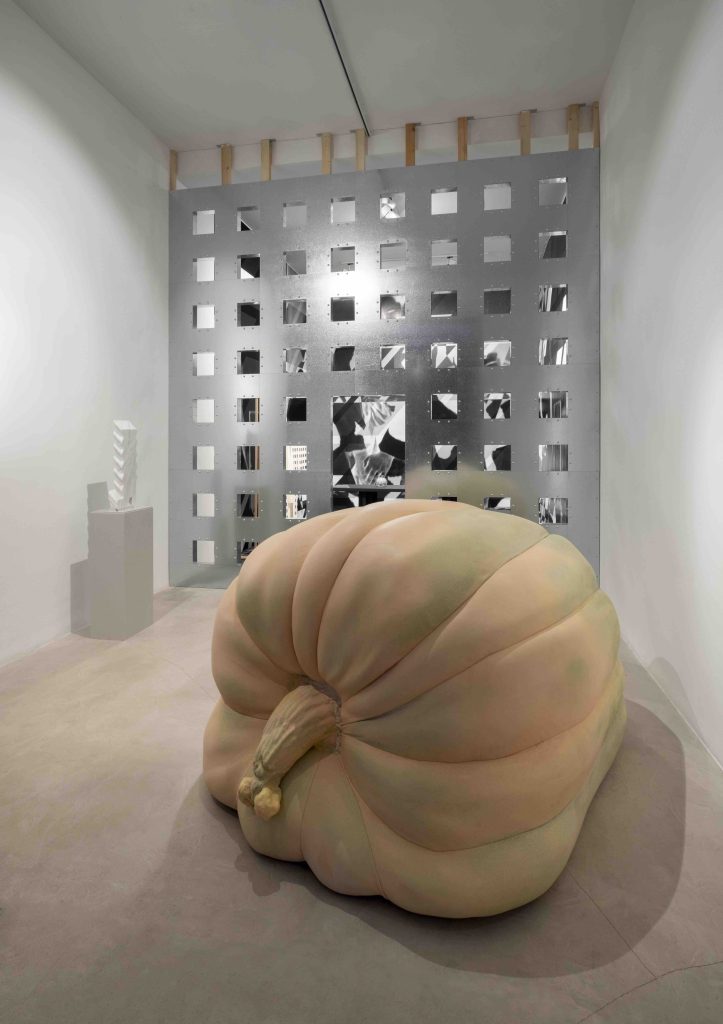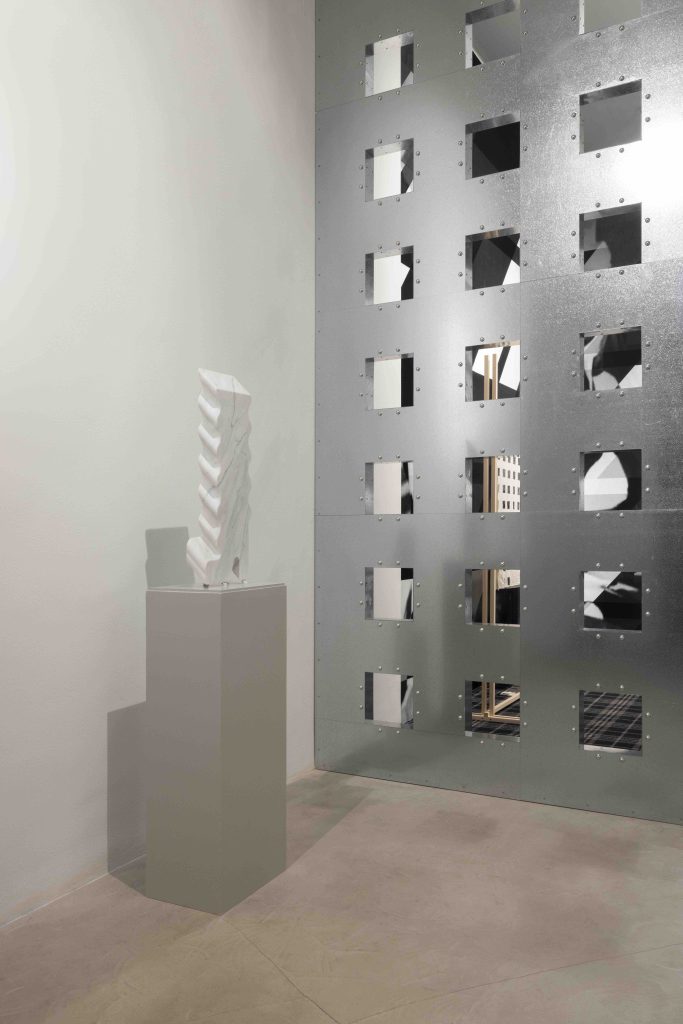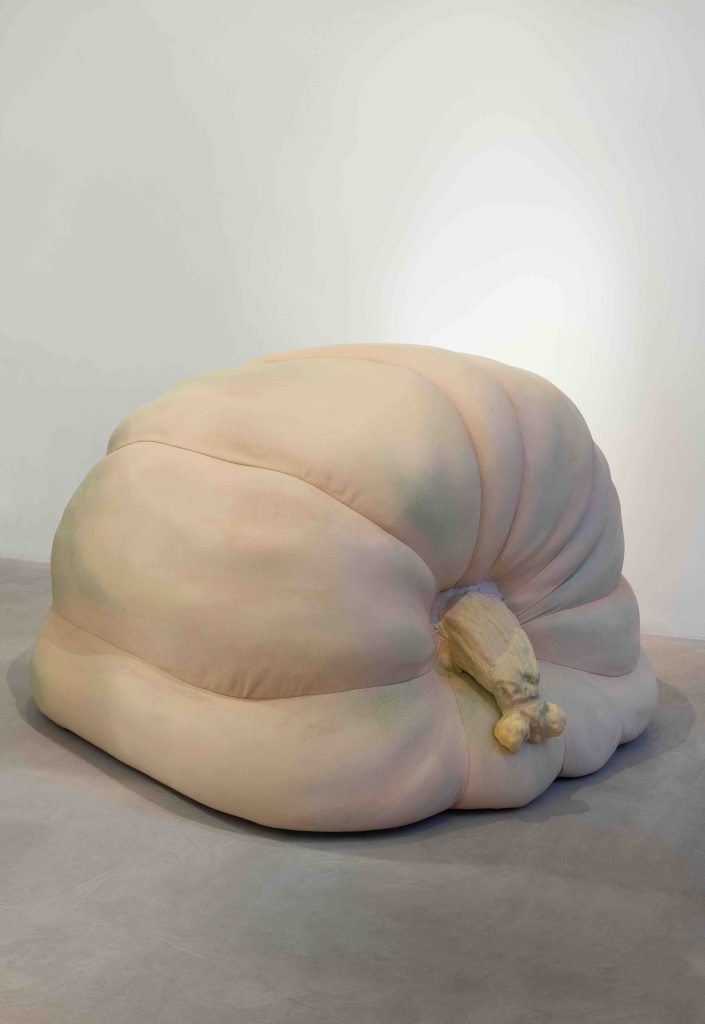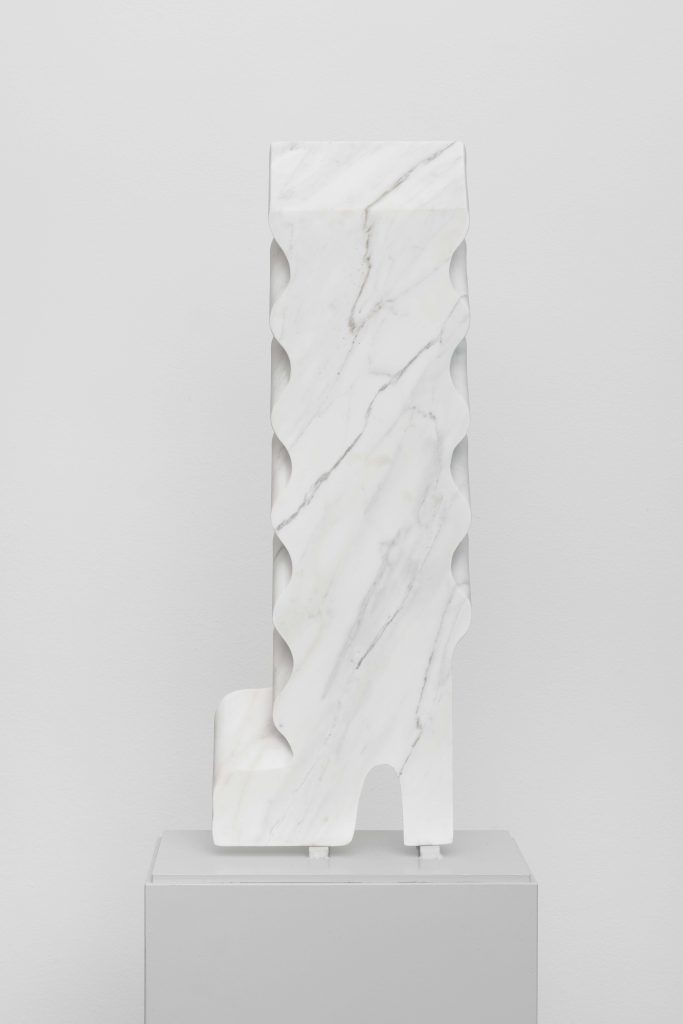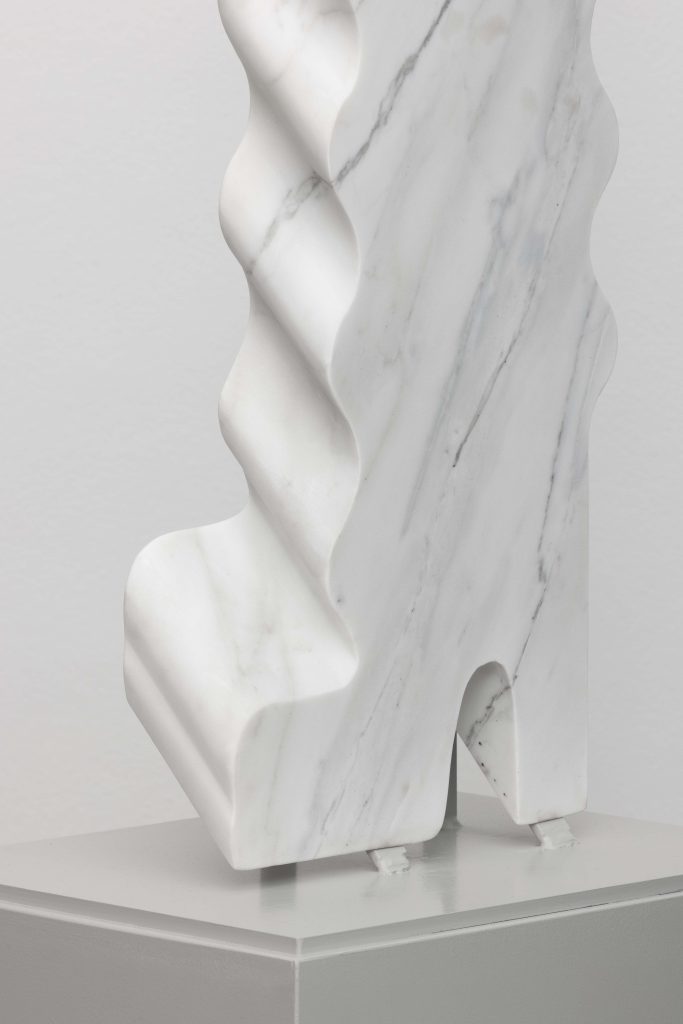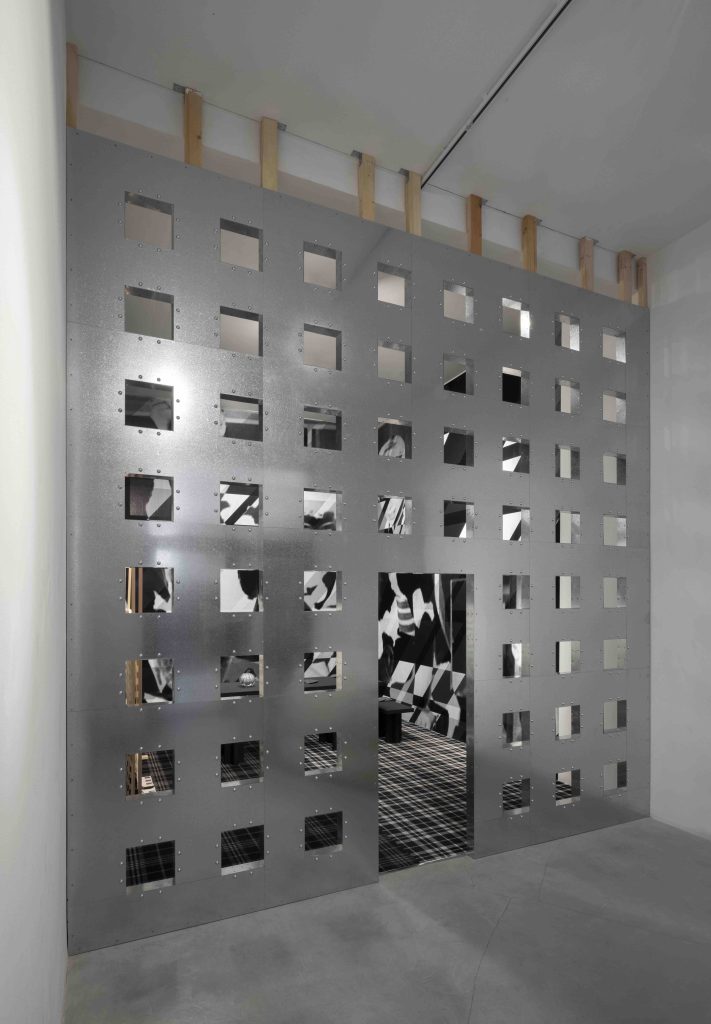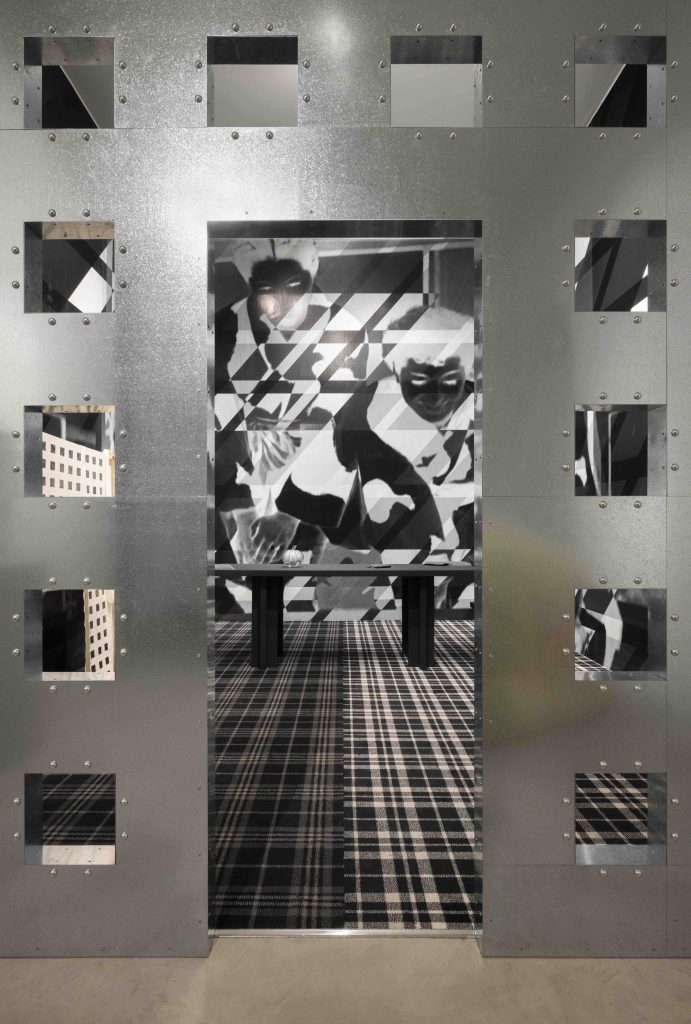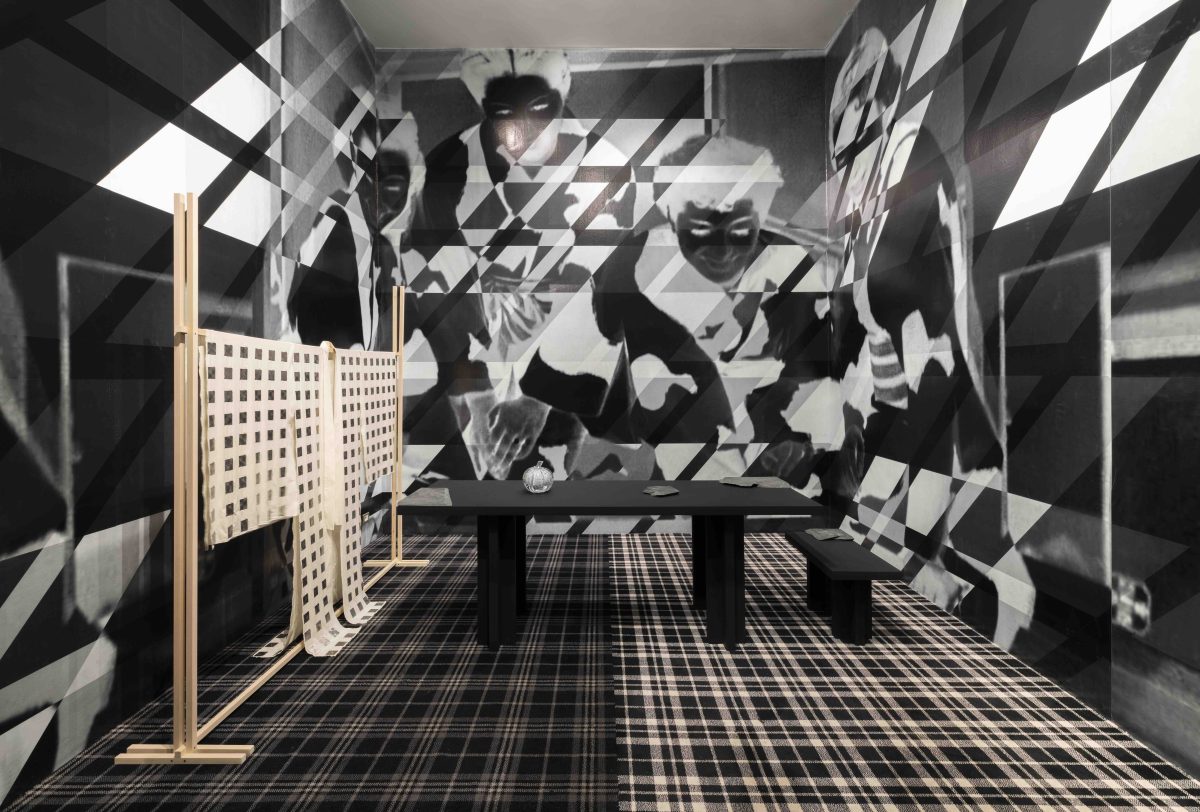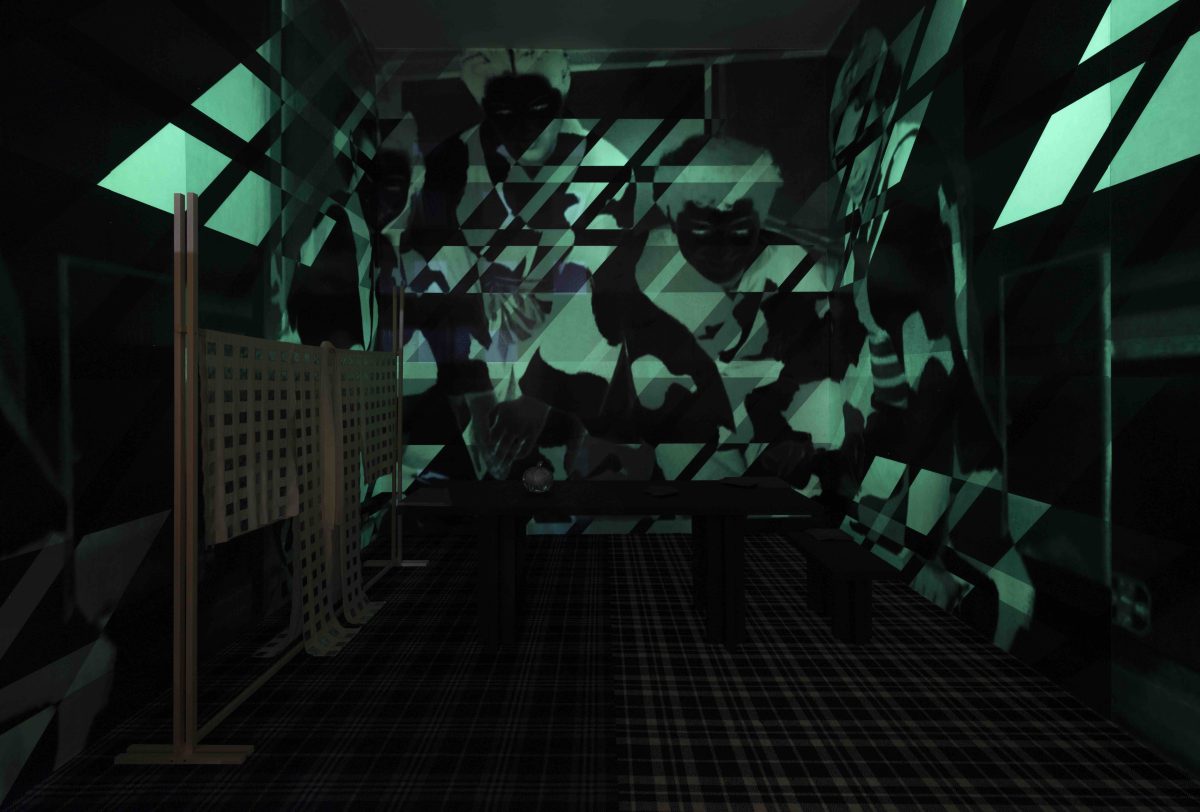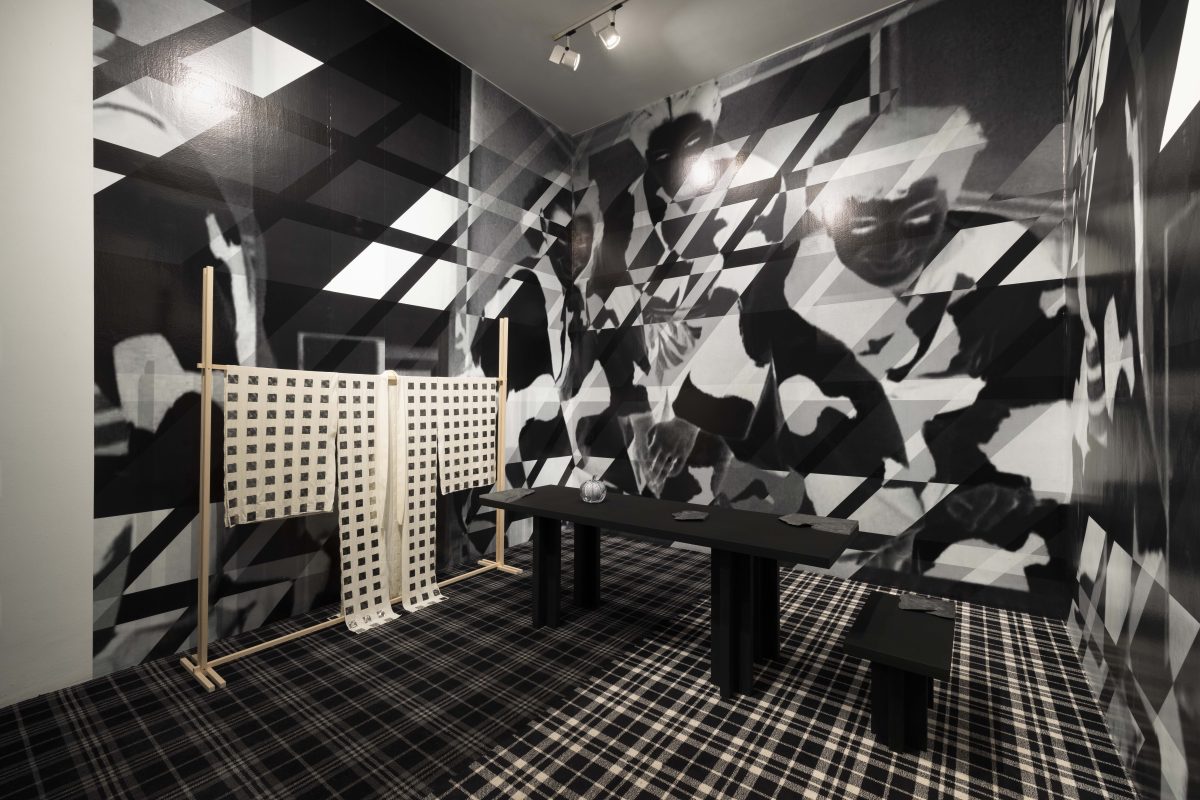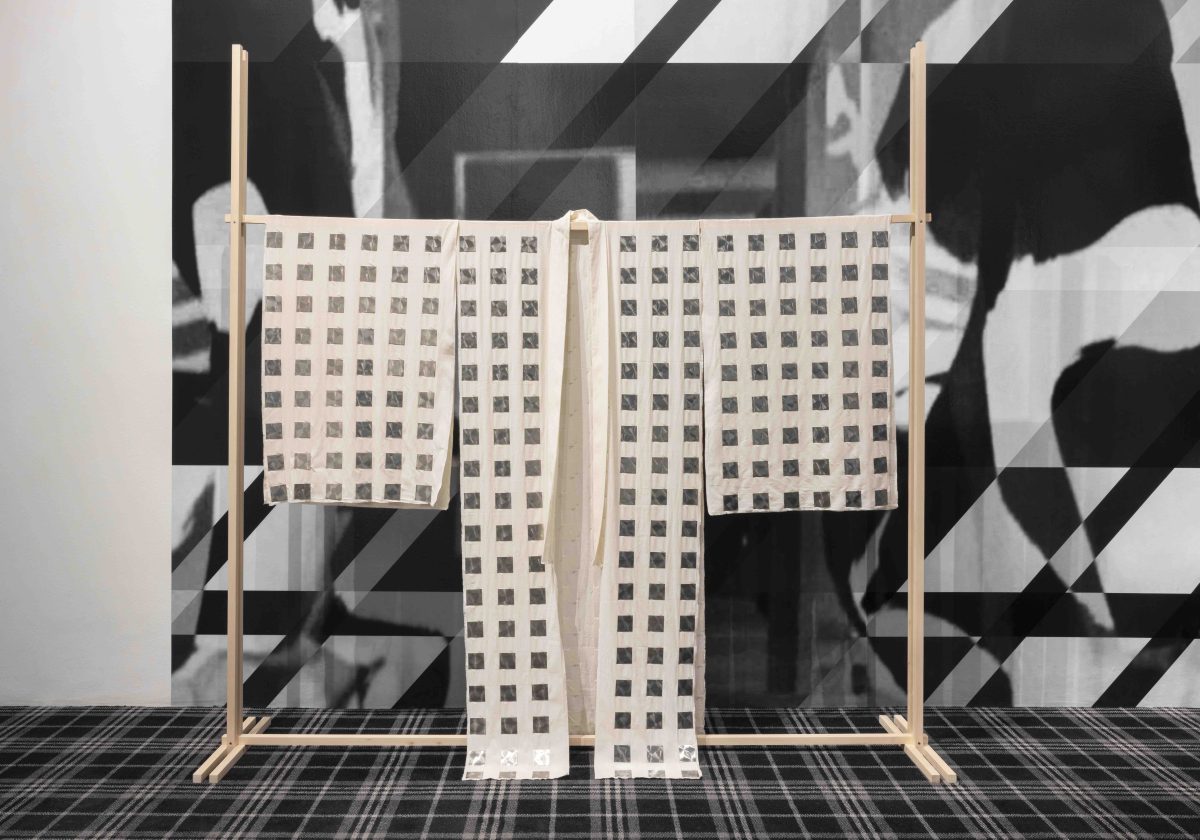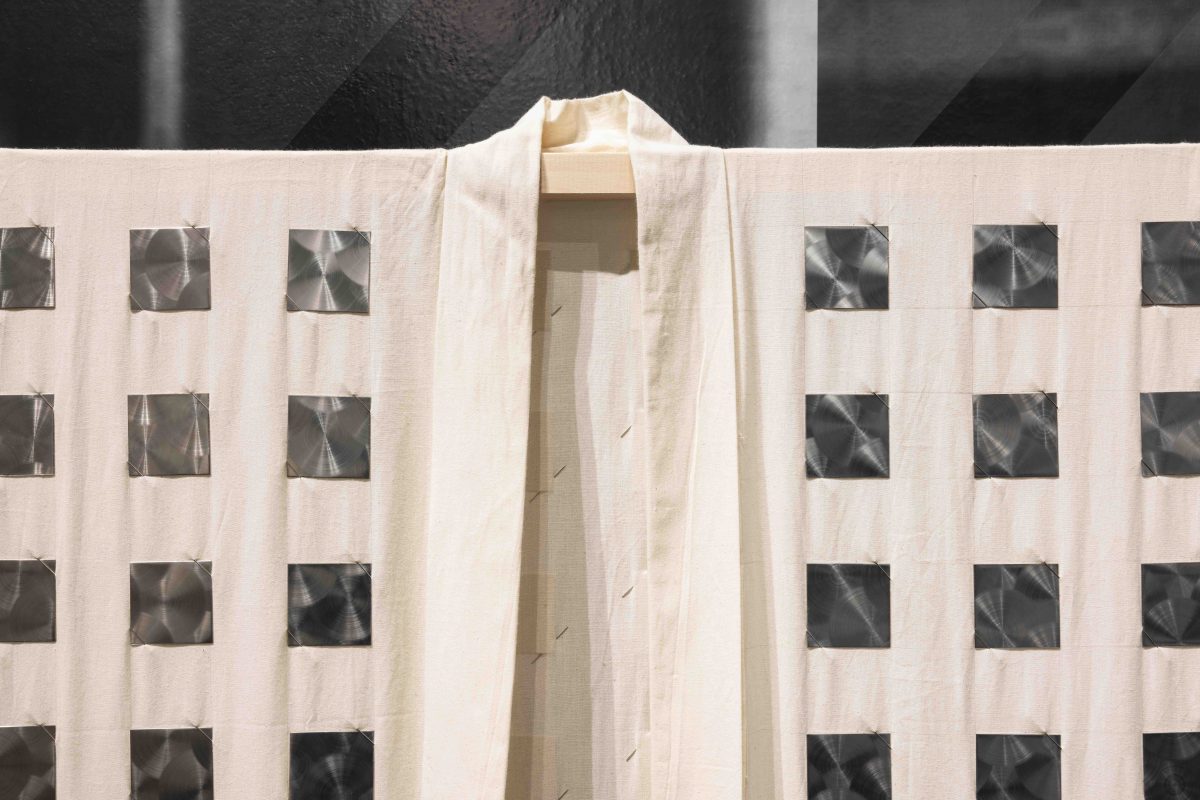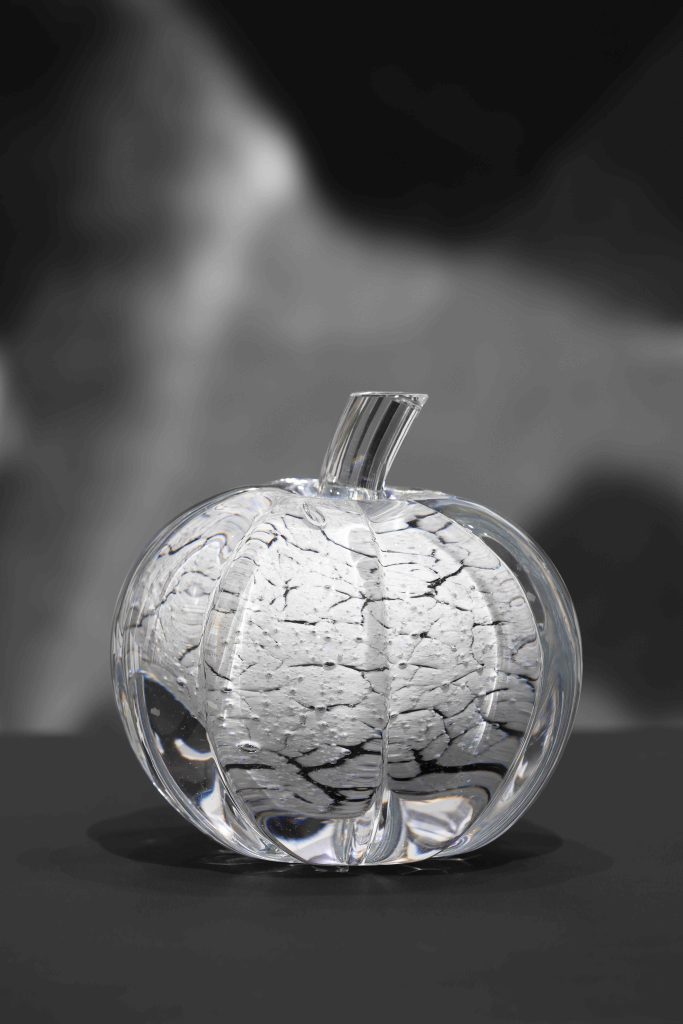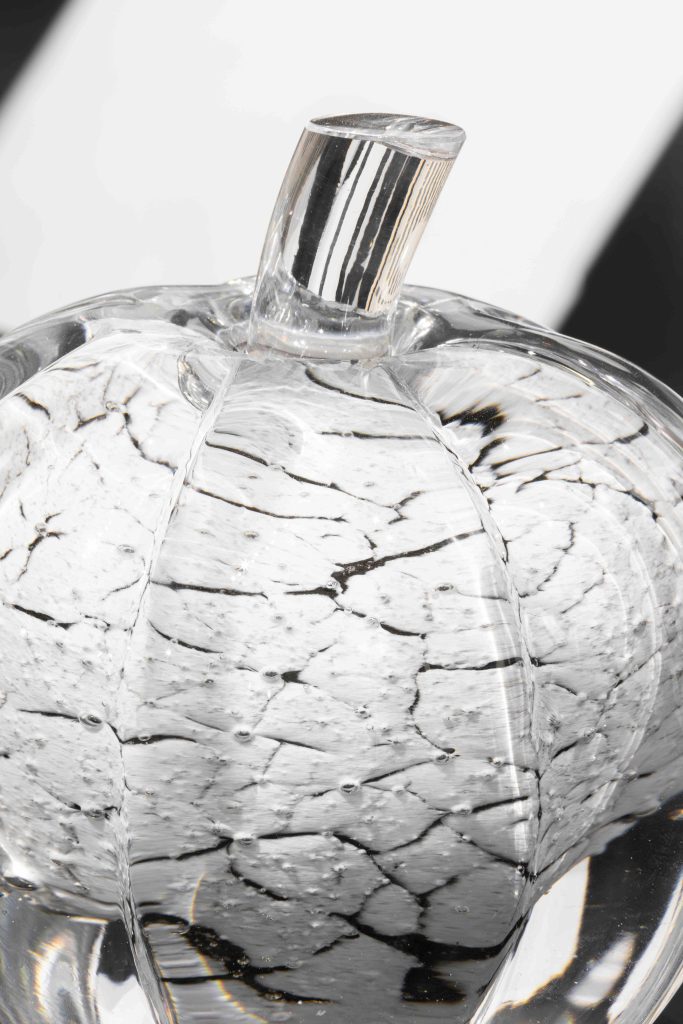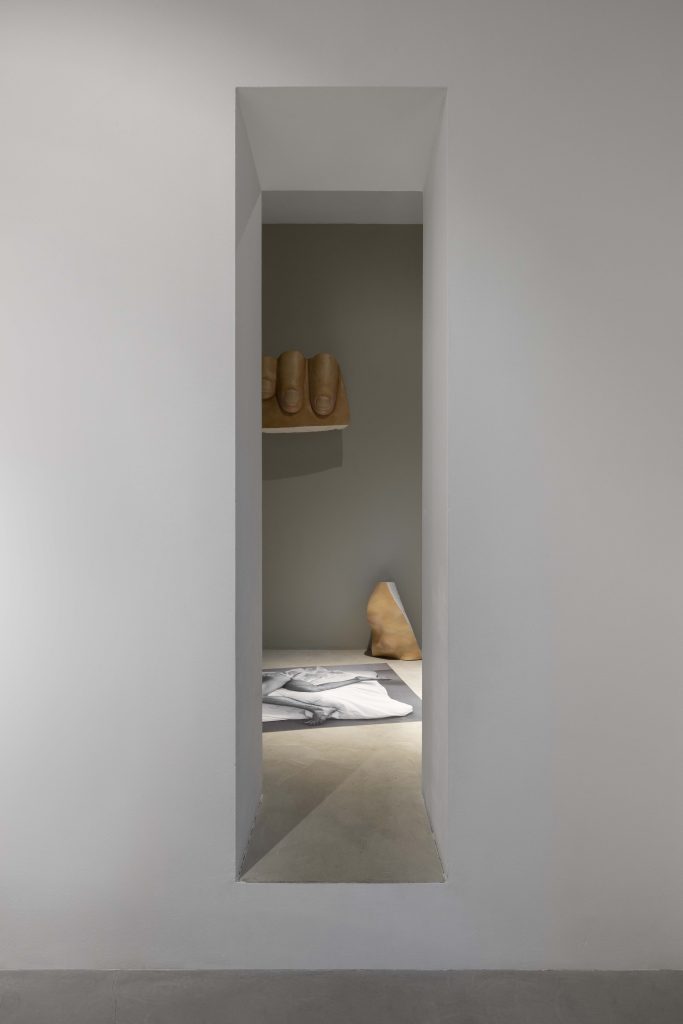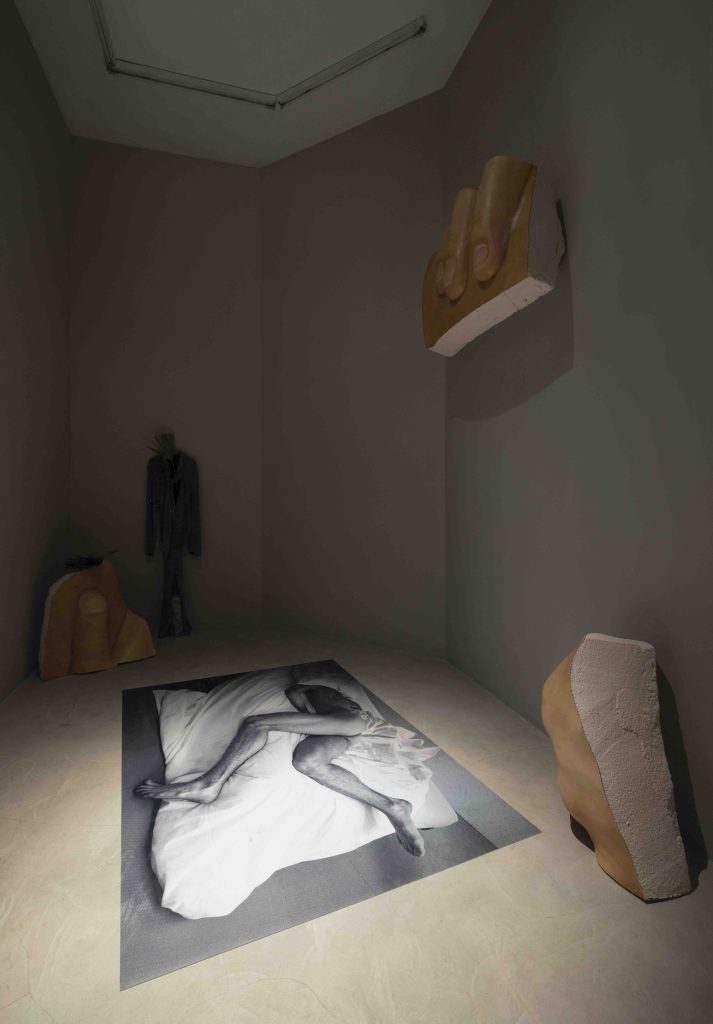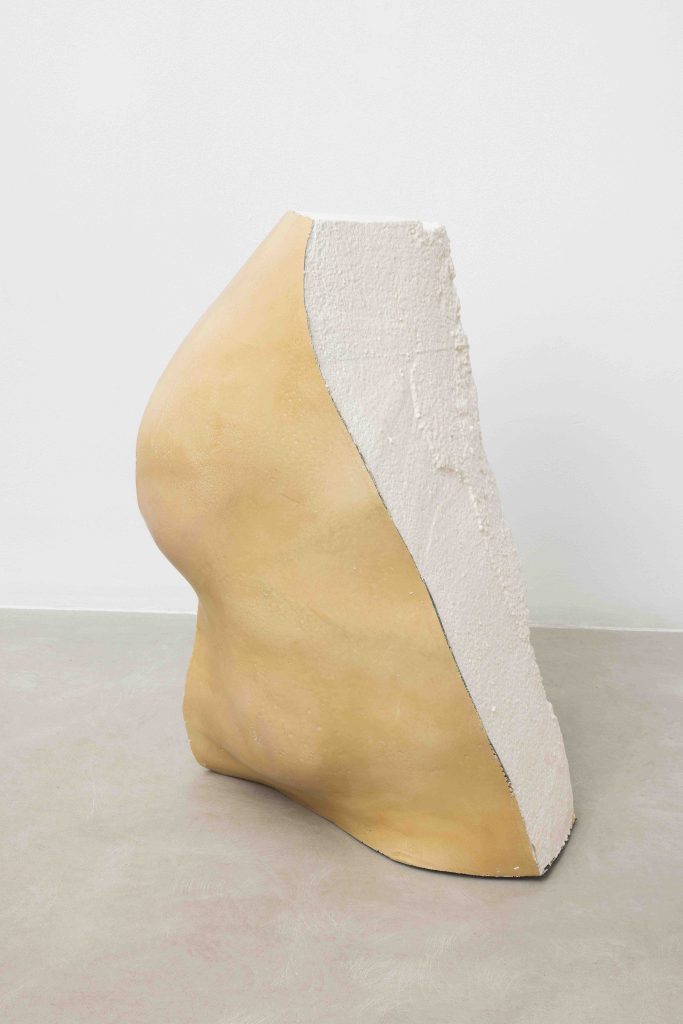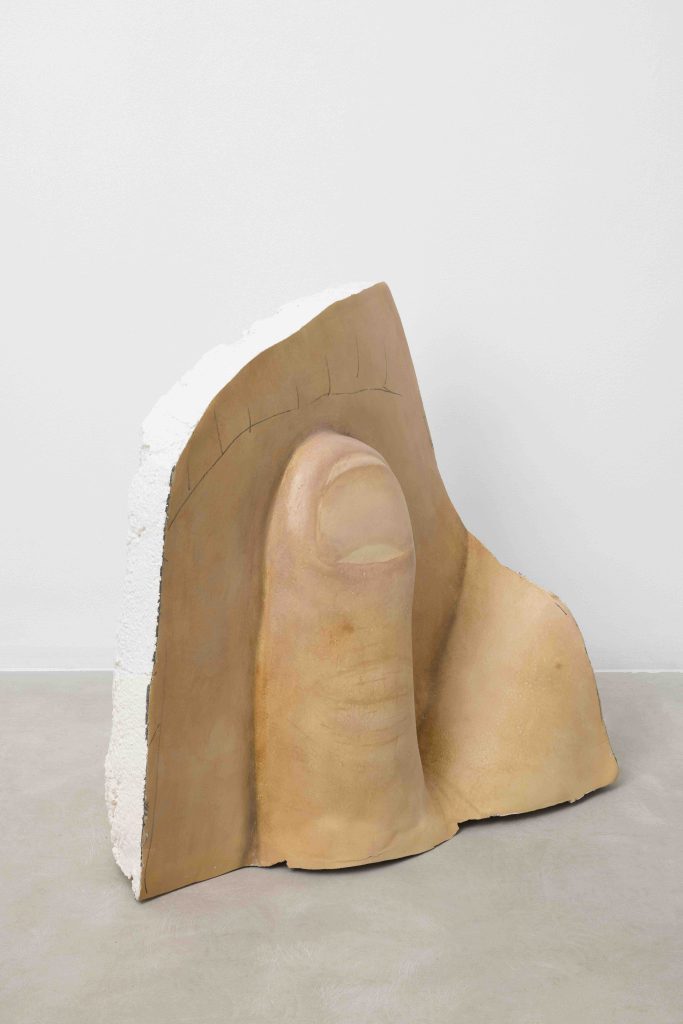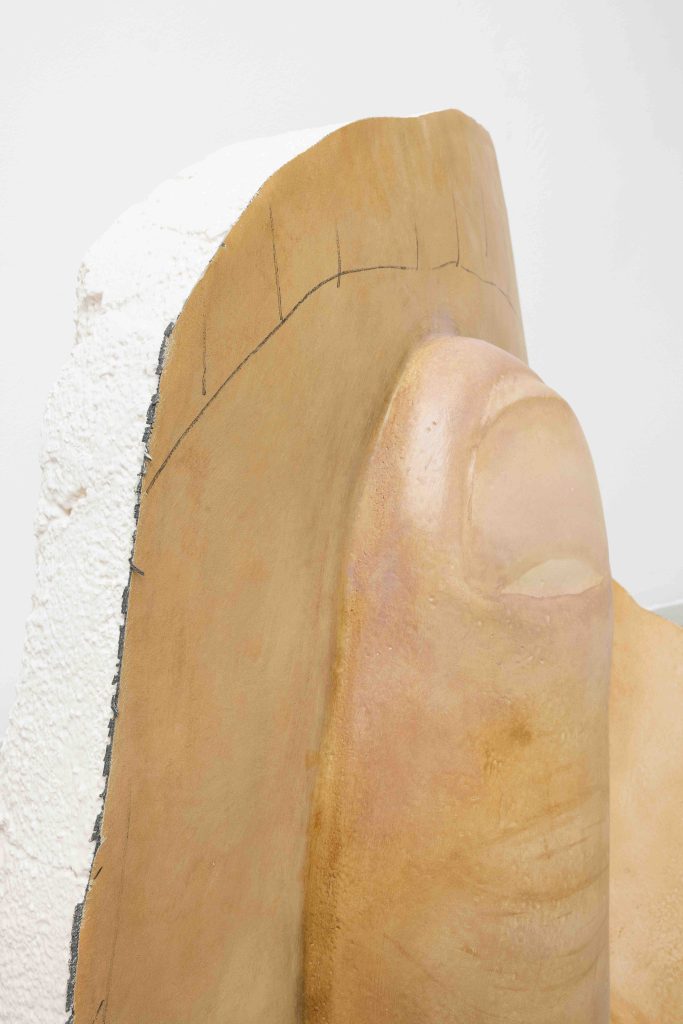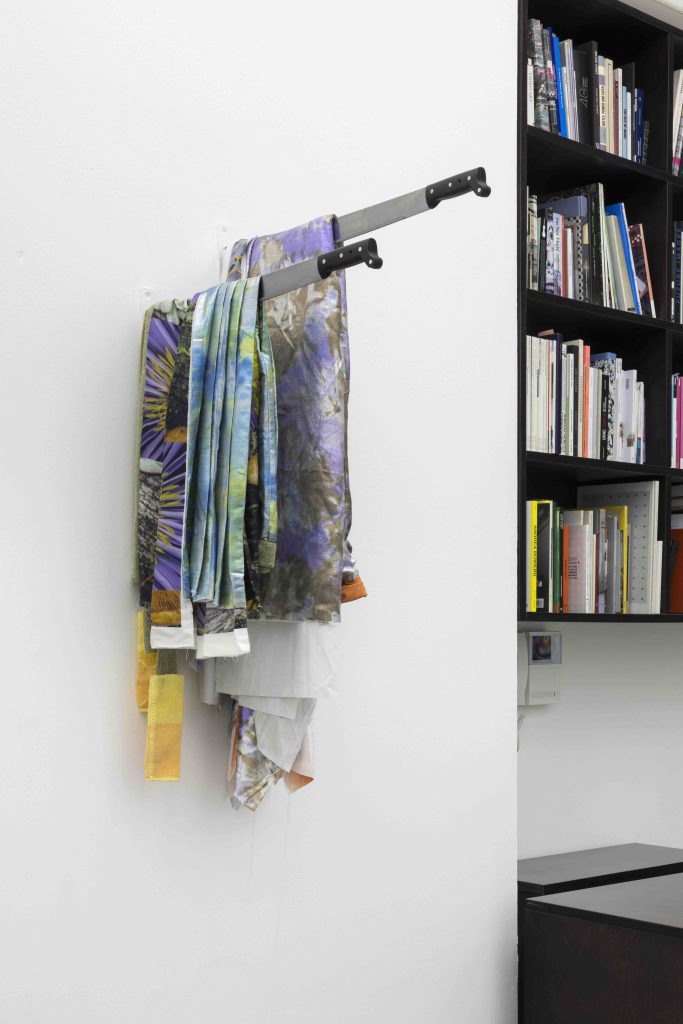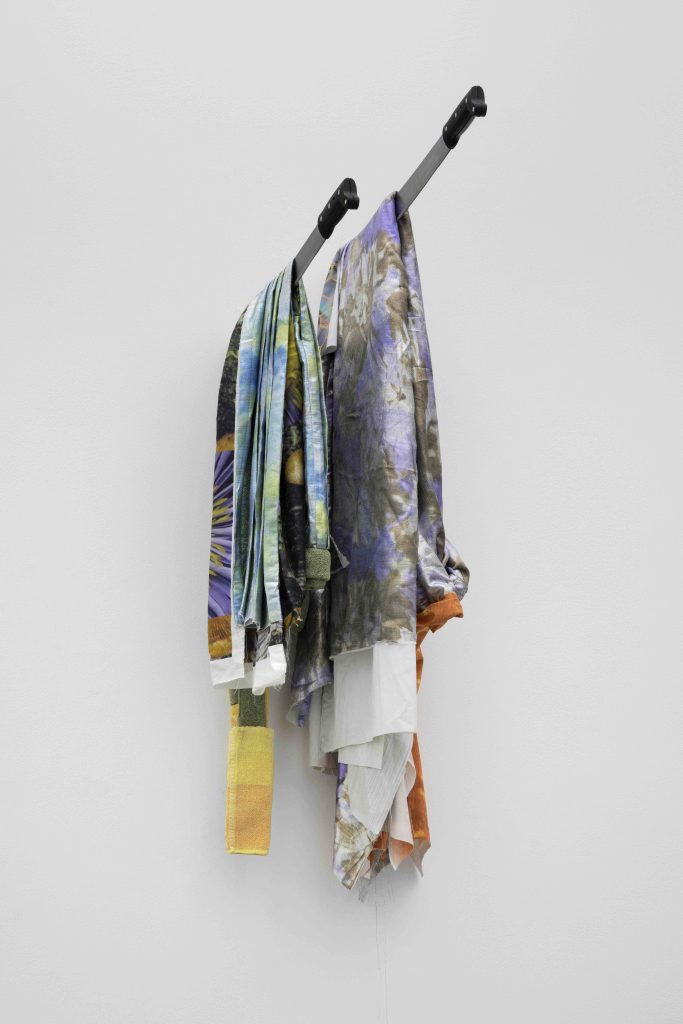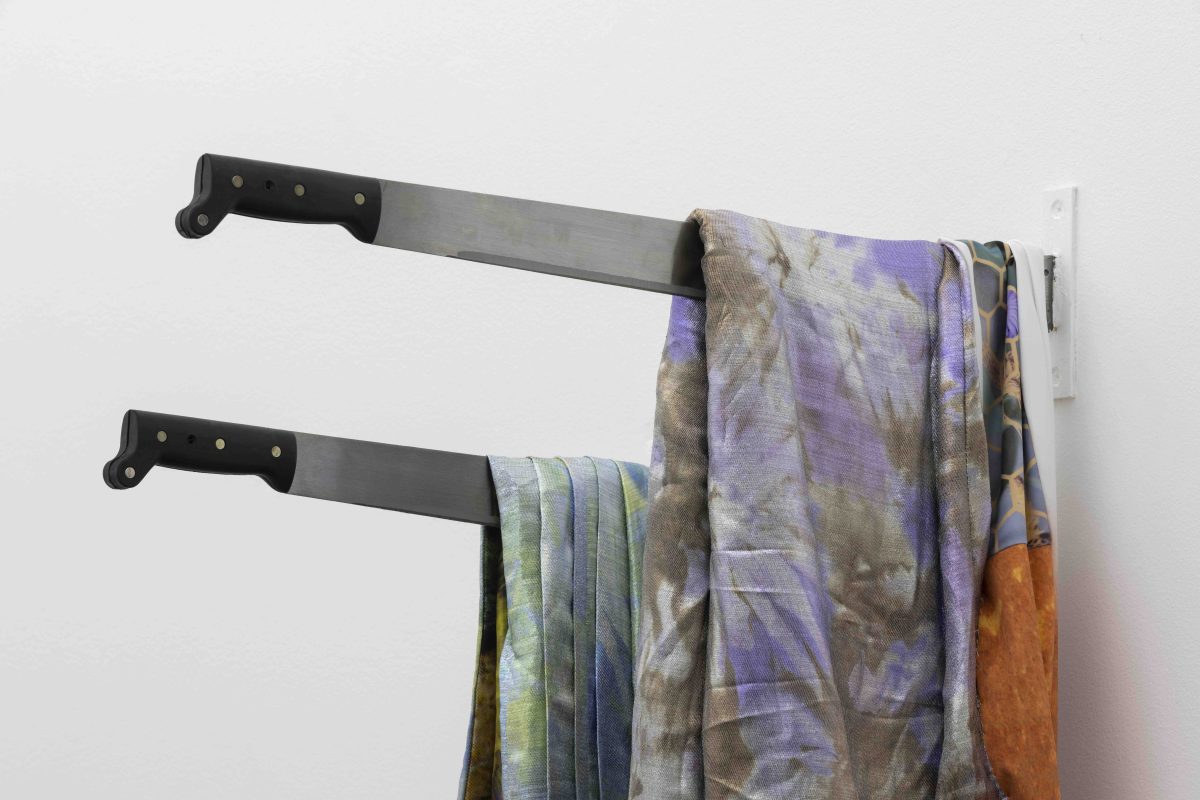
- This event has passed.
kaufmann repetto is pleased to present ‘Cold, Cold Heart’, Anthea Hamilton’s second solo show with the gallery. An immersive, site-specific installation that offers thematic environments, where architectural interventions and artworks coalesce into a kaleidoscopic, open-ended narration.
Galvanized steel walls, of imposing height and featuring a severe geometric pattern, alter the symmetric layout of the gallery spaces, create differently sized atria. The rhythmic articulation of the square-shaped openings, framed by the cold neatness of the surrounding metal, is reminiscent of a wide range of architectural vocabularies, ranging from the grilles of cloistered convents to the palisades of medieval fortresses, from tessellation in Islamic art to the hard-edged soberness of Italian rationalist architecture. These accurate, metallic gates set the tone for a highly stylized, unemotional atmosphere that – at first glance – seems to predominate the installation. Patterns and grid systems, a recurring obsession in Hamilton’s practice, also return in individual artworks. A slanted version of the Hamilton tartan, referring to the artist’s surname, becomes the leitmotif in the right-hand atrium. Blasians (The Flavour of Green Tea over Rice), a glow-in-the-dark vinyl wallpaper, features a still from Yasujrō Ozu’s cinematographic masterpiece from 1952. The inverted image, depicting four smiling women clad in kimonos, is interwoven with the tartan motif, which returns also on the carpet covering the floor also. In the same environment, the squares of circular polished stainless steel pinned to the Metal Wave Kimono tribute both to the grid drawings of American painter Agnes Martin and to the Japanese seigaha pattern, a geometric design of layered concentric circles representing ocean waves.
If the apparent neutrality of systems and pattern constitutes on the one hand a kind of contemplative hortus conclusus (an “enclosed garden”), its methodical, stylistic unity is at the same time open to be subverted by playful juxtapositions and unexpected cohabitations. Lit every morning, the scent of Incense (Search Mi Heart) pervades the exhibition space. The fragrance, developed in collaboration between the artist and olfactive designer Ezra-Lloyd Jackson, releases aromas of menthol and wooden ambre, which – triggering the trigeminal nerve – suggest to our nervous system the sensation of coldness offset by a gentle sweetness. The incense, fixed on curly branches protruding from the grid walls, creates an aromatic frame for the show while its smoke visually softens the sharpness of the materials and architectural elements.
By the same token, the sensual softness of botanical specimens and human bodies are interspersed throughout the exhibition. Hamilton’s long-term fascination with the aesthetic qualities of vegetables translates into the hand-blown glass object Cold Heart Squash. Created by the artist in collaboration with LOEWE and covered in pale leather, the Giant Pumpkin Nr. 3 is voluptuously sprawling on the floor. The immoderate, carnal shape of the ripe fruit and the tactile seductiveness of its soft, matt surface evokes a naked human body, overtly playing with the eroticized ambiguity of the pumpkin’s stems and cavities. This is further explored in Project for a Door (SculptureCenter), a piece inspired by Gaetano Pesce’s proposal for an entrance to a skyscraper in Manhattan. Representing a man spreading his butt cheeks, the Italian designer’s project was never realized, but Hamilton revisited it for her solo show at New York’s SculptureCenter, which earned her the nomination to Britain’s Turner Prize in 2016. In the current Milanese version, only some parts – a single human butt cheek, some fingers – are sticking out of the wall. In the same space, a floor mat depicting a male nude back in a black-and-white shoot, realized by Hamilton with Lewis Ronald and Jonathon Luke Baker, is imbued with the aesthetics of fashion photograph.
The tension between subjective gaze and the object is further enquired in Sleeping Kimono, installed on a floor of grey basalt stone. Spread out on top of synthetic rubber and a series of concrete cylinders, blurry photographs are printed on a silk satin fabric, its T-shaped cut alluding to the iconographic Japanese garment. The images are based on Leni Riefenstahl’s 1973 documentation of the Nuba population, the indigenous inhabitants of central Sudan. The cylinders placed under the cloth evoke a form or a shape – maybe human ribs or the oars of a boat – hidden from our sight. This device further distorts the image – not only the print but the object itself.
kaufmann repetto ha il piacere di presentare ‘Cold, Cold Heart’ di Anthea Hamilton. La seconda personale dell’artista con la galleria è un’installazione site-specific immersiva, che propone contesti tematici dove interventi architettonici e opere si fondono in un’unica narrazione caleidoscopica.
Imponenti pareti di acciaio galvanizzato con un rigoroso motivo geometrico alterano la disposizione simmetrica degli spazi espositivi della galleria, creando atri di dimensioni diverse. La ritmica articolazione delle aperture quadrate, incorniciate dal metallo algido, allude a una serie di archetipi architettonici che spaziano dalle grate dei conventi di clausura alle palizzate delle fortezze medievali, dal tassellamento dell’arte islamica alla sobrietà rigorosa dell’architettura razionalista. Queste recinzioni metalliche regolari creano un’atmosfera stilizzata e distaccata che a prima vista sembra dominare l’istallazione. Pattern e motivi a griglia, un’ossessione ricorrente nel lavoro di Hamilton, ritornano anche nelle singole opere. Una versione obliqua del tartan Hamilton, che rimanda al cognome dell’artista, diventa il leitmotiv dell’atrio destro. Blasians (The Flavour of Green Tea over Rice), una carta da parati vinilica fluorescente, riproduce un fermo immagine dal capolavoro cinematografico del 1952 di Yasujrō Ozu, Il sapore del riso al tè verde. L’immagine invertita che ritrae quattro donne in kimono s’intreccia al motivo del tartan, che ritorna anche nel tappeto che copre il pavimento. Nello stesso ambiente, appuntate al Metal Wave Kimono, placche quadrate di acciaio inossidabile levigato a cerchi rendono omaggio sia alle griglie dei disegni della pittrice americana Agnes Martin, sia al motivo giapponese seigaha, un disegno geometrico di cerchi concentrici sovrapposti che rappresenta le onde dell’oceano.
Se da un lato l’apparente neutralità di sistemi e motivi regolari rappresenta una specie di hortus conclusus contemplativo, al tempo stesso la sua metodica unità stilistica si presta a essere sovvertita da giocose giustapposizioni e associazioni inattese. Accesa ogni mattino, la fragranza di un incenso pervade lo spazio espositivo. Incense (Search Mi Heart), nata dalla collaborazione tra l’artista e il designer olfattivo Ezra-Lloyd Jackson, rilascia aromi di mentolo e ambrato legnoso che, attivando il nervo trigemino, suggeriscono al nostro sistema nervoso una sensazione di freddo compensata da una delicata dolcezza. L’incenso, fissato su rami sinuosi che sporgono dalle pareti di metallo, crea una cornice aromatica per la mostra mentre il fumo smussa la spigolosità dei materiali e degli elementi architettonici. Allo stesso modo, esemplari vegetali e corpi umani si alternano negli spazi espositivi con la loro sensuale morbidezza. La lunga fascinazione di Hamilton per le qualità estetiche degli ortaggi si evidenzia negli oggetti di vetro soffiato realizzati a mano, come Cold Heart Squash. Realizzata dall’artista in collaborazione con LOEWE e ricoperta da una pallida pelle, la Giant Pumpkin Nr. 3 si adagia voluttuosamente sul pavimento. La sovrabbondante carnalità del frutto maturo e il fascino tattile della sua morbida superficie evocano un corpo umano nudo, giocando esplicitamente con l’ambiguità erotizzata dei gambi e delle cavità della zucca. Concetto esplorato ulteriormente in Project for a Door (SculptureCenter), un’opera ispirata alla proposta di Gaetano Pesce per l’ingresso di un grattacielo di Manhattan. Rappresentazione di un uomo che allarga le proprie natiche, il progetto non è mai stato realizzato ma Hamilton lo ha rivisitato per la propria personale allo SculptureCenter di New York che le è valsa la candidatura al Turner Prize del 2016. Nell’attuale versione milanese emergono dal muro solo alcune parti – una singola natica e alcune dita. Nello stesso spazio, un tappeto raffigurante una schiena maschile nuda in uno scatto in bianco e nero, realizzato da Hamilton con Lewis Ronald e Jonathon Luke Baker, è permeato dell’estetica della fotografia di moda.
La tensione tra sguardo soggettivo e oggetto è approfondita in Sleeping Kimono, installata su un pavimento di pietra basaltica grigia. Un raso di seta il cui taglio a T allude all’iconico vestito giapponese è adagiato su una gomma sintetica poggiata a sua volta su una serie di cilindri di cemento. Sul tessuto sono stampate fotografie sfocate, immagini che si basano sulla documentazione che Leni Riefenstahl realizzò nel 1973 sul popolo Nuba, gli abitanti indigeni della parte centrale del Sudan. I cilindri sotto la stoffa evocano una forma o una sagoma – forse costole umane, o remi di una barca – nascosta al nostro sguardo. Questo espediente distorce ulteriormente l’immagine – non solo la stampa, ma l’oggetto stesso.

